Learning Outcomes and Assessment Feedback for Desklib
VerifiedAdded on 2023/06/08
|19
|5814
|489
AI Summary
This article discusses Learning Outcomes and Assessment Feedback for Desklib. It covers topics such as the link between strategic management and leadership, impact of management and leadership styles on strategic decisions, leadership styles that can be adapted to different situations, impact of selected theories of management and leadership on organizational strategy, and creating a leadership strategy that supports organizational direction.
Contribute Materials
Your contribution can guide someone’s learning journey. Share your
documents today.
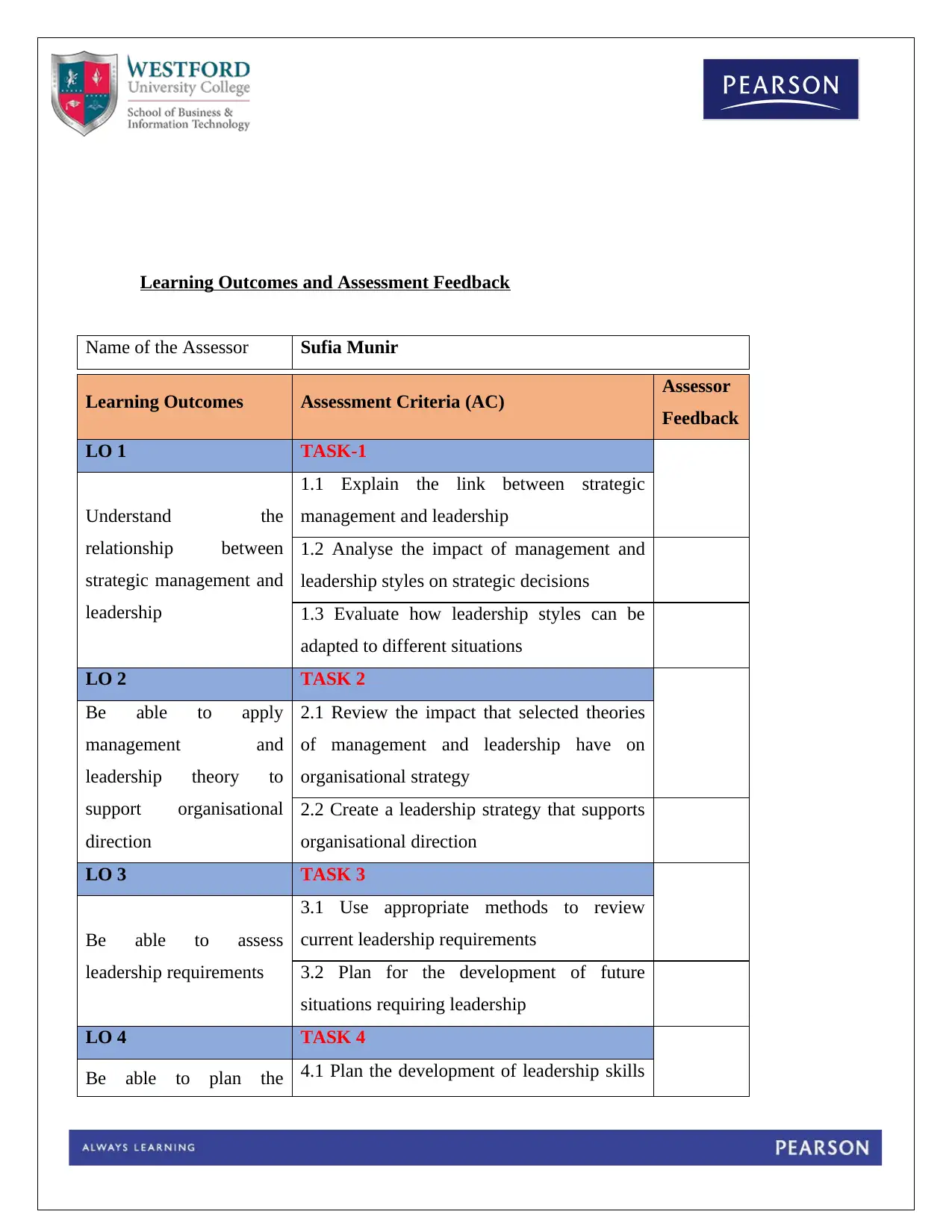
Learning Outcomes and Assessment Feedback
Name of the Assessor Sufia Munir
Learning Outcomes Assessment Criteria (AC) Assessor
Feedback
LO 1 TASK-1
Understand the
relationship between
strategic management and
leadership
1.1 Explain the link between strategic
management and leadership
1.2 Analyse the impact of management and
leadership styles on strategic decisions
1.3 Evaluate how leadership styles can be
adapted to different situations
LO 2 TASK 2
Be able to apply
management and
leadership theory to
support organisational
direction
2.1 Review the impact that selected theories
of management and leadership have on
organisational strategy
2.2 Create a leadership strategy that supports
organisational direction
LO 3 TASK 3
Be able to assess
leadership requirements
3.1 Use appropriate methods to review
current leadership requirements
3.2 Plan for the development of future
situations requiring leadership
LO 4 TASK 4
Be able to plan the 4.1 Plan the development of leadership skills
Name of the Assessor Sufia Munir
Learning Outcomes Assessment Criteria (AC) Assessor
Feedback
LO 1 TASK-1
Understand the
relationship between
strategic management and
leadership
1.1 Explain the link between strategic
management and leadership
1.2 Analyse the impact of management and
leadership styles on strategic decisions
1.3 Evaluate how leadership styles can be
adapted to different situations
LO 2 TASK 2
Be able to apply
management and
leadership theory to
support organisational
direction
2.1 Review the impact that selected theories
of management and leadership have on
organisational strategy
2.2 Create a leadership strategy that supports
organisational direction
LO 3 TASK 3
Be able to assess
leadership requirements
3.1 Use appropriate methods to review
current leadership requirements
3.2 Plan for the development of future
situations requiring leadership
LO 4 TASK 4
Be able to plan the 4.1 Plan the development of leadership skills
Secure Best Marks with AI Grader
Need help grading? Try our AI Grader for instant feedback on your assignments.
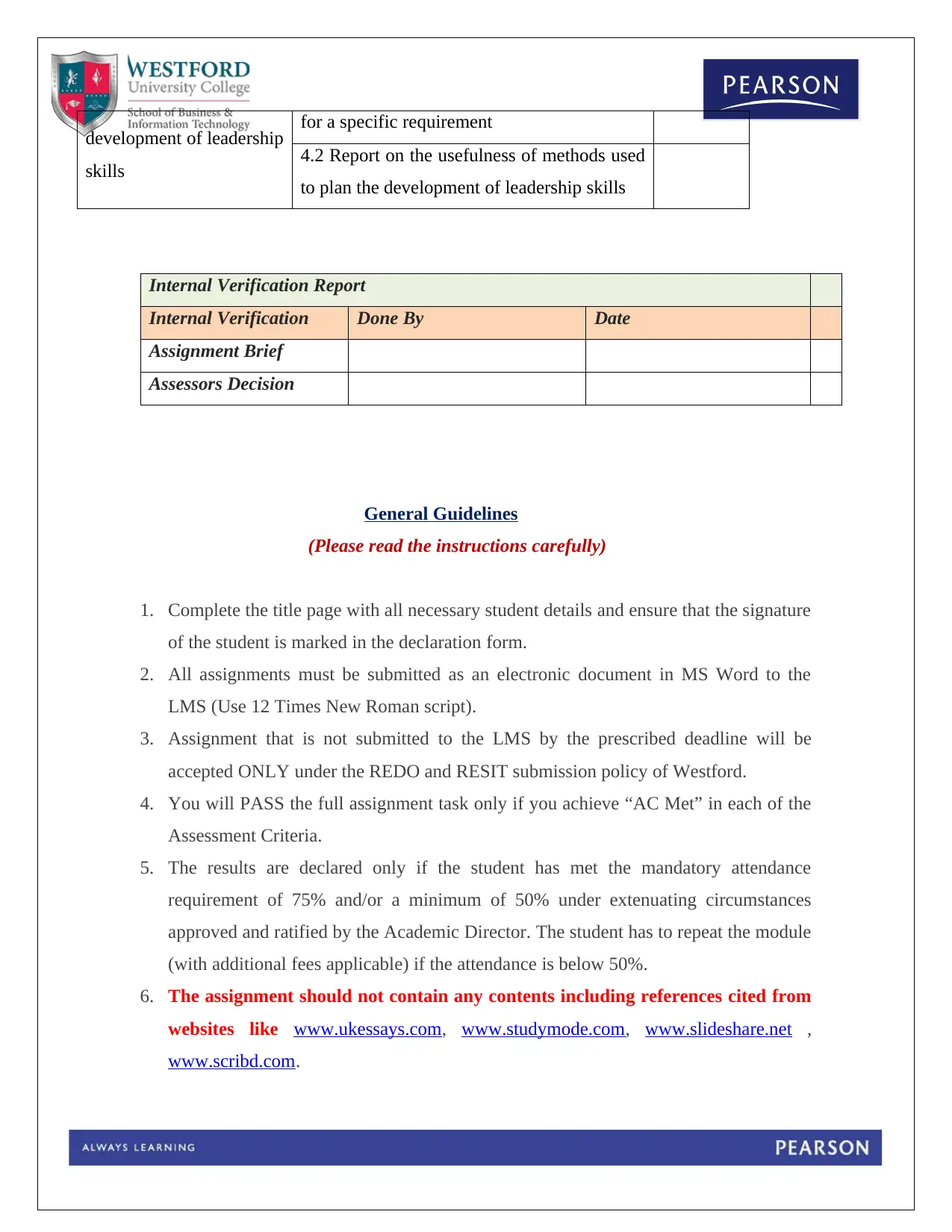
development of leadership
skills
for a specific requirement
4.2 Report on the usefulness of methods used
to plan the development of leadership skills
Internal Verification Report
Internal Verification Done By Date
Assignment Brief
Assessors Decision
General Guidelines
(Please read the instructions carefully)
1. Complete the title page with all necessary student details and ensure that the signature
of the student is marked in the declaration form.
2. All assignments must be submitted as an electronic document in MS Word to the
LMS (Use 12 Times New Roman script).
3. Assignment that is not submitted to the LMS by the prescribed deadline will be
accepted ONLY under the REDO and RESIT submission policy of Westford.
4. You will PASS the full assignment task only if you achieve “AC Met” in each of the
Assessment Criteria.
5. The results are declared only if the student has met the mandatory attendance
requirement of 75% and/or a minimum of 50% under extenuating circumstances
approved and ratified by the Academic Director. The student has to repeat the module
(with additional fees applicable) if the attendance is below 50%.
6. The assignment should not contain any contents including references cited from
websites like www.ukessays.com, www.studymode.com, www.slideshare.net ,
www.scribd.com.
skills
for a specific requirement
4.2 Report on the usefulness of methods used
to plan the development of leadership skills
Internal Verification Report
Internal Verification Done By Date
Assignment Brief
Assessors Decision
General Guidelines
(Please read the instructions carefully)
1. Complete the title page with all necessary student details and ensure that the signature
of the student is marked in the declaration form.
2. All assignments must be submitted as an electronic document in MS Word to the
LMS (Use 12 Times New Roman script).
3. Assignment that is not submitted to the LMS by the prescribed deadline will be
accepted ONLY under the REDO and RESIT submission policy of Westford.
4. You will PASS the full assignment task only if you achieve “AC Met” in each of the
Assessment Criteria.
5. The results are declared only if the student has met the mandatory attendance
requirement of 75% and/or a minimum of 50% under extenuating circumstances
approved and ratified by the Academic Director. The student has to repeat the module
(with additional fees applicable) if the attendance is below 50%.
6. The assignment should not contain any contents including references cited from
websites like www.ukessays.com, www.studymode.com, www.slideshare.net ,
www.scribd.com.
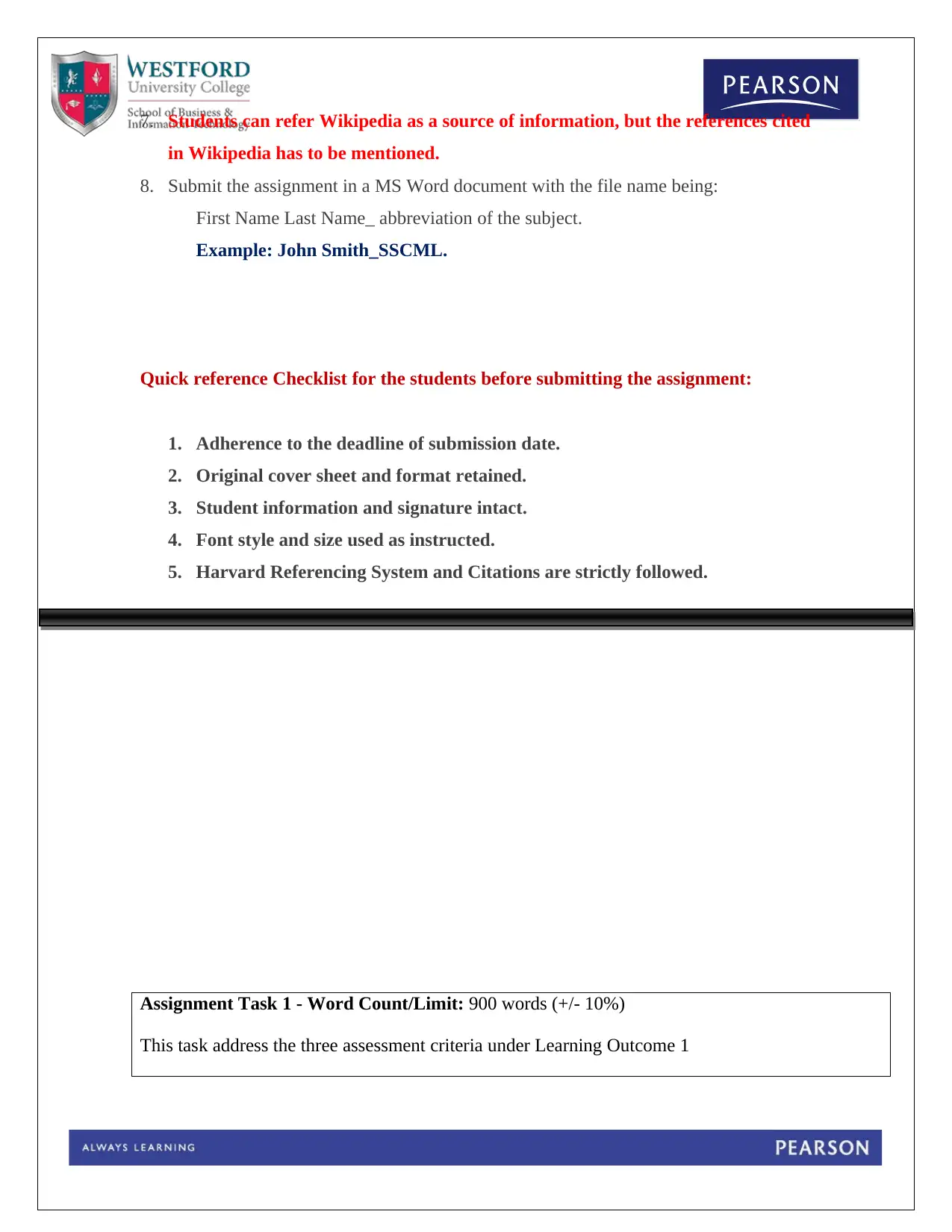
7. Students can refer Wikipedia as a source of information, but the references cited
in Wikipedia has to be mentioned.
8. Submit the assignment in a MS Word document with the file name being:
First Name Last Name_ abbreviation of the subject.
Example: John Smith_SSCML.
Quick reference Checklist for the students before submitting the assignment:
1. Adherence to the deadline of submission date.
2. Original cover sheet and format retained.
3. Student information and signature intact.
4. Font style and size used as instructed.
5. Harvard Referencing System and Citations are strictly followed.
Assignment Task 1 - Word Count/Limit: 900 words (+/- 10%)
This task address the three assessment criteria under Learning Outcome 1
in Wikipedia has to be mentioned.
8. Submit the assignment in a MS Word document with the file name being:
First Name Last Name_ abbreviation of the subject.
Example: John Smith_SSCML.
Quick reference Checklist for the students before submitting the assignment:
1. Adherence to the deadline of submission date.
2. Original cover sheet and format retained.
3. Student information and signature intact.
4. Font style and size used as instructed.
5. Harvard Referencing System and Citations are strictly followed.
Assignment Task 1 - Word Count/Limit: 900 words (+/- 10%)
This task address the three assessment criteria under Learning Outcome 1
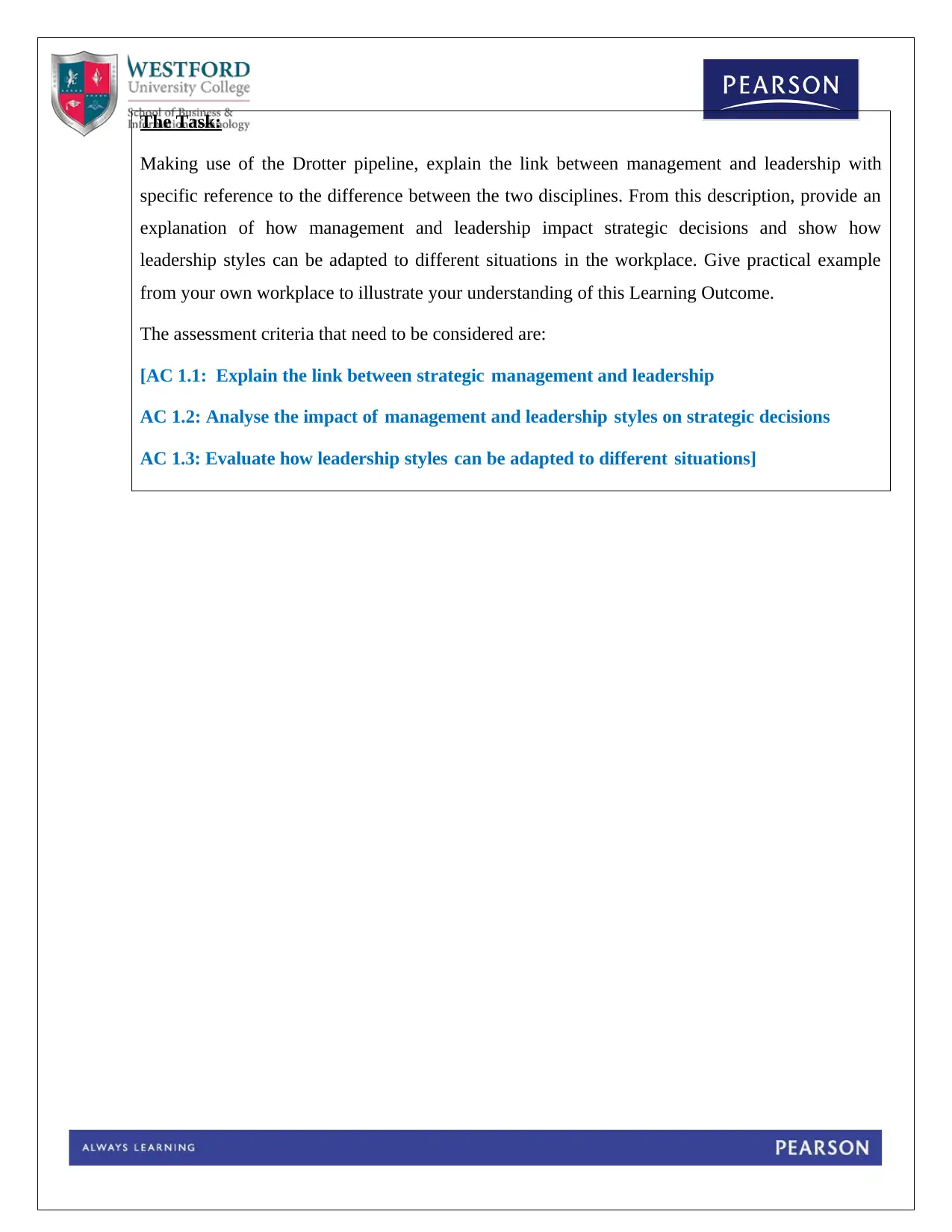
The Task:
Making use of the Drotter pipeline, explain the link between management and leadership with
specific reference to the difference between the two disciplines. From this description, provide an
explanation of how management and leadership impact strategic decisions and show how
leadership styles can be adapted to different situations in the workplace. Give practical example
from your own workplace to illustrate your understanding of this Learning Outcome.
The assessment criteria that need to be considered are:
[AC 1.1: Explain the link between strategic management and leadership
AC 1.2: Analyse the impact of management and leadership styles on strategic decisions
AC 1.3: Evaluate how leadership styles can be adapted to different situations]
Making use of the Drotter pipeline, explain the link between management and leadership with
specific reference to the difference between the two disciplines. From this description, provide an
explanation of how management and leadership impact strategic decisions and show how
leadership styles can be adapted to different situations in the workplace. Give practical example
from your own workplace to illustrate your understanding of this Learning Outcome.
The assessment criteria that need to be considered are:
[AC 1.1: Explain the link between strategic management and leadership
AC 1.2: Analyse the impact of management and leadership styles on strategic decisions
AC 1.3: Evaluate how leadership styles can be adapted to different situations]
Secure Best Marks with AI Grader
Need help grading? Try our AI Grader for instant feedback on your assignments.
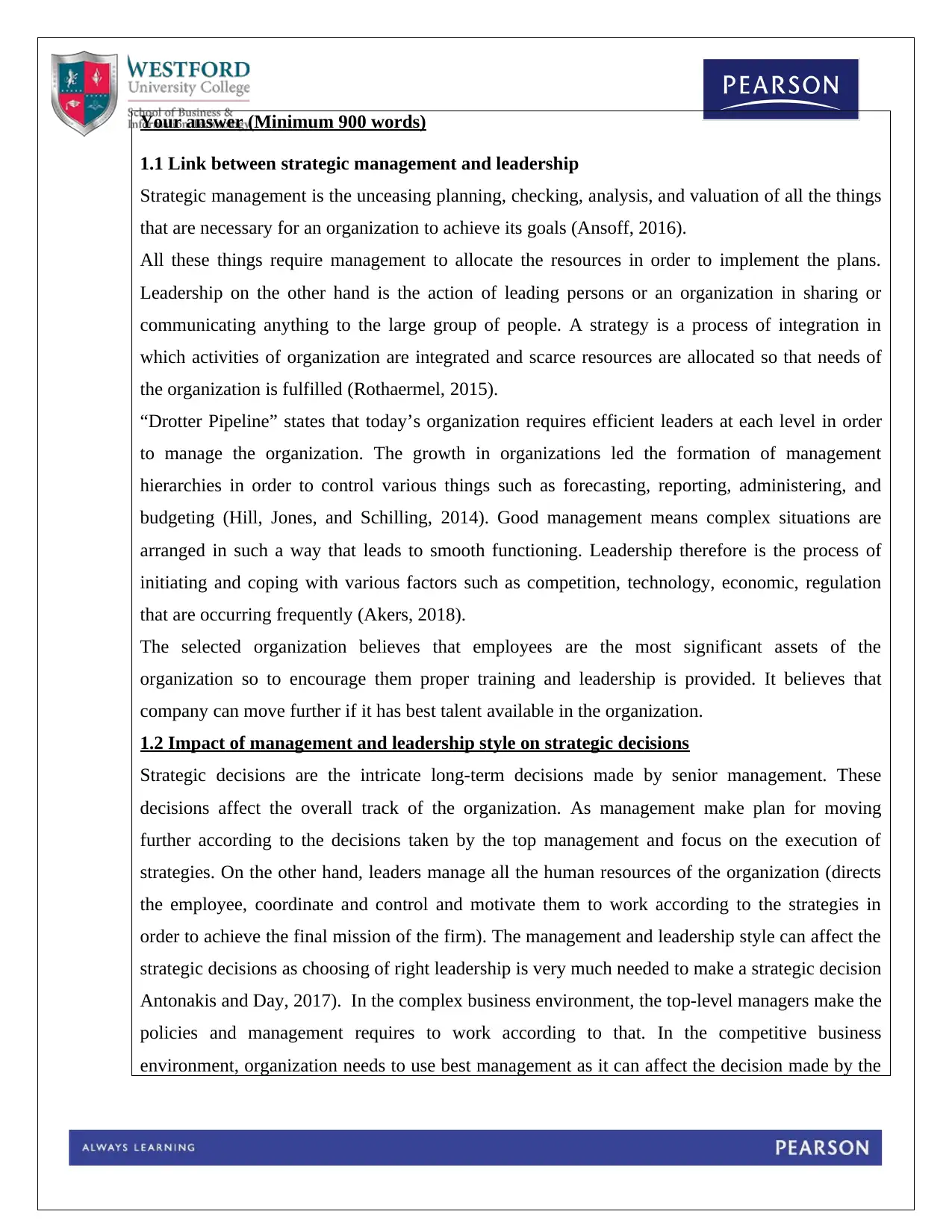
Your answer (Minimum 900 words)
1.1 Link between strategic management and leadership
Strategic management is the unceasing planning, checking, analysis, and valuation of all the things
that are necessary for an organization to achieve its goals (Ansoff, 2016).
All these things require management to allocate the resources in order to implement the plans.
Leadership on the other hand is the action of leading persons or an organization in sharing or
communicating anything to the large group of people. A strategy is a process of integration in
which activities of organization are integrated and scarce resources are allocated so that needs of
the organization is fulfilled (Rothaermel, 2015).
“Drotter Pipeline” states that today’s organization requires efficient leaders at each level in order
to manage the organization. The growth in organizations led the formation of management
hierarchies in order to control various things such as forecasting, reporting, administering, and
budgeting (Hill, Jones, and Schilling, 2014). Good management means complex situations are
arranged in such a way that leads to smooth functioning. Leadership therefore is the process of
initiating and coping with various factors such as competition, technology, economic, regulation
that are occurring frequently (Akers, 2018).
The selected organization believes that employees are the most significant assets of the
organization so to encourage them proper training and leadership is provided. It believes that
company can move further if it has best talent available in the organization.
1.2 Impact of management and leadership style on strategic decisions
Strategic decisions are the intricate long-term decisions made by senior management. These
decisions affect the overall track of the organization. As management make plan for moving
further according to the decisions taken by the top management and focus on the execution of
strategies. On the other hand, leaders manage all the human resources of the organization (directs
the employee, coordinate and control and motivate them to work according to the strategies in
order to achieve the final mission of the firm). The management and leadership style can affect the
strategic decisions as choosing of right leadership is very much needed to make a strategic decision
Antonakis and Day, 2017). In the complex business environment, the top-level managers make the
policies and management requires to work according to that. In the competitive business
environment, organization needs to use best management as it can affect the decision made by the
1.1 Link between strategic management and leadership
Strategic management is the unceasing planning, checking, analysis, and valuation of all the things
that are necessary for an organization to achieve its goals (Ansoff, 2016).
All these things require management to allocate the resources in order to implement the plans.
Leadership on the other hand is the action of leading persons or an organization in sharing or
communicating anything to the large group of people. A strategy is a process of integration in
which activities of organization are integrated and scarce resources are allocated so that needs of
the organization is fulfilled (Rothaermel, 2015).
“Drotter Pipeline” states that today’s organization requires efficient leaders at each level in order
to manage the organization. The growth in organizations led the formation of management
hierarchies in order to control various things such as forecasting, reporting, administering, and
budgeting (Hill, Jones, and Schilling, 2014). Good management means complex situations are
arranged in such a way that leads to smooth functioning. Leadership therefore is the process of
initiating and coping with various factors such as competition, technology, economic, regulation
that are occurring frequently (Akers, 2018).
The selected organization believes that employees are the most significant assets of the
organization so to encourage them proper training and leadership is provided. It believes that
company can move further if it has best talent available in the organization.
1.2 Impact of management and leadership style on strategic decisions
Strategic decisions are the intricate long-term decisions made by senior management. These
decisions affect the overall track of the organization. As management make plan for moving
further according to the decisions taken by the top management and focus on the execution of
strategies. On the other hand, leaders manage all the human resources of the organization (directs
the employee, coordinate and control and motivate them to work according to the strategies in
order to achieve the final mission of the firm). The management and leadership style can affect the
strategic decisions as choosing of right leadership is very much needed to make a strategic decision
Antonakis and Day, 2017). In the complex business environment, the top-level managers make the
policies and management requires to work according to that. In the competitive business
environment, organization needs to use best management as it can affect the decision made by the

top level (Hale, 2017). Leadership and Management theories are significant for articulating,
implementing, and directing the strategies of any organization. Different management theories like
functional theory, contingency theory, situational theory, behavioral theory can be used in taking
strategic decisions. Same as different leadership styles can be used in implementation of strategies
(Osland, 2017).While taking a strategic decision, if appropriate leadership style is not adopted then
it can lead to failure of decision. Therefore, it is necessary for the organization to adopt right
leadership style.
1.3 Different leadership style to adopt in different situations
Autocratic leadership- in this type of leadership, employees are not allowed to take
decision, they are only the followers of the elision that is taken by leader. This leadership style is
used in those situations when the organization has to take fast decision. In case of fast decision-
making, organization cannot waste time to consult employees (Nanjundeswaraswamy and Swamy,
2014)
Bureaucratic leadership- these leaders follow the organization procedure strictly. This style
is best for those situations where exact standard is required to follow. This style helps organization
leadership
styles
authocratic
leadership
charismatic
leadership
democratic
leadership
laissez-faire
leadership
bureaucratic
leadership
implementing, and directing the strategies of any organization. Different management theories like
functional theory, contingency theory, situational theory, behavioral theory can be used in taking
strategic decisions. Same as different leadership styles can be used in implementation of strategies
(Osland, 2017).While taking a strategic decision, if appropriate leadership style is not adopted then
it can lead to failure of decision. Therefore, it is necessary for the organization to adopt right
leadership style.
1.3 Different leadership style to adopt in different situations
Autocratic leadership- in this type of leadership, employees are not allowed to take
decision, they are only the followers of the elision that is taken by leader. This leadership style is
used in those situations when the organization has to take fast decision. In case of fast decision-
making, organization cannot waste time to consult employees (Nanjundeswaraswamy and Swamy,
2014)
Bureaucratic leadership- these leaders follow the organization procedure strictly. This style
is best for those situations where exact standard is required to follow. This style helps organization
leadership
styles
authocratic
leadership
charismatic
leadership
democratic
leadership
laissez-faire
leadership
bureaucratic
leadership
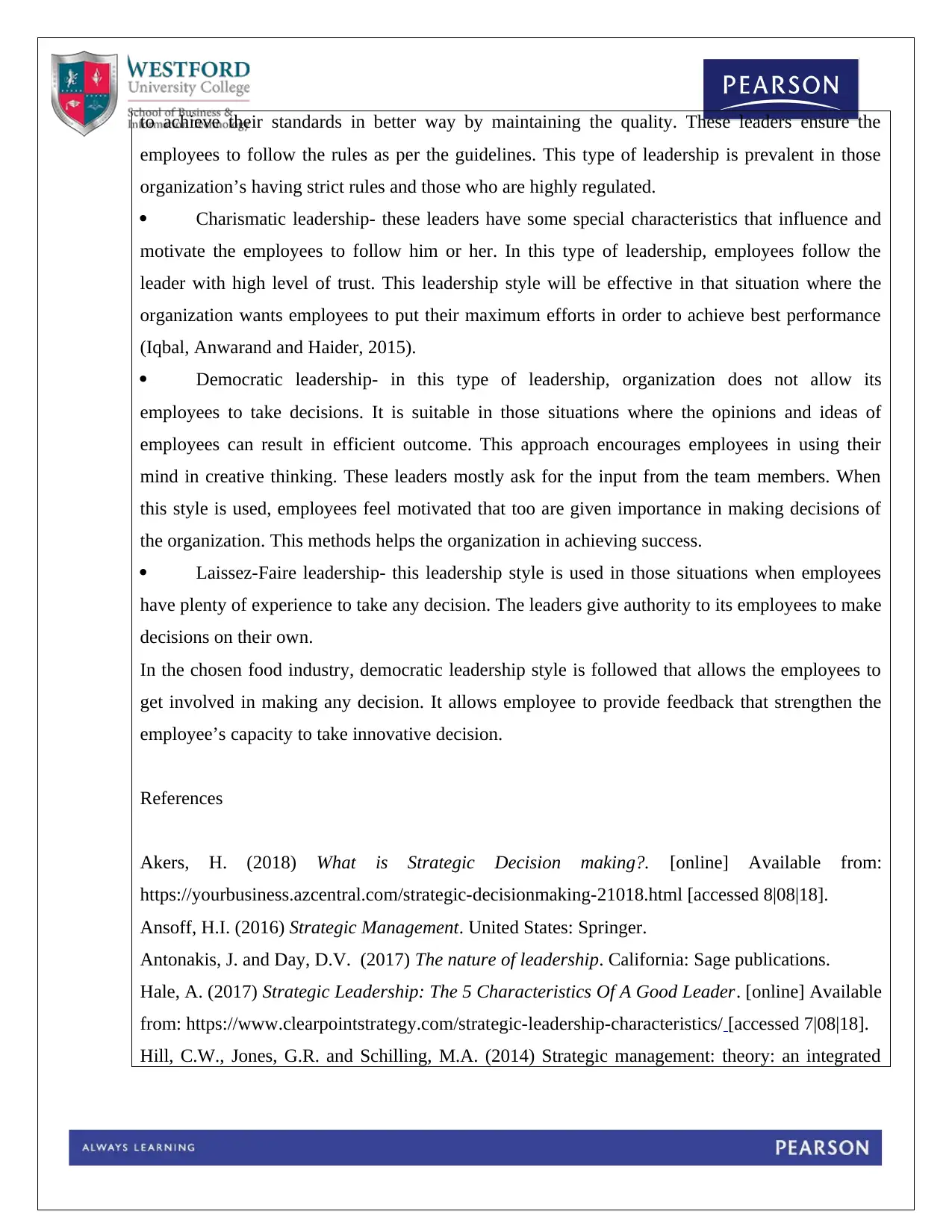
to achieve their standards in better way by maintaining the quality. These leaders ensure the
employees to follow the rules as per the guidelines. This type of leadership is prevalent in those
organization’s having strict rules and those who are highly regulated.
Charismatic leadership- these leaders have some special characteristics that influence and
motivate the employees to follow him or her. In this type of leadership, employees follow the
leader with high level of trust. This leadership style will be effective in that situation where the
organization wants employees to put their maximum efforts in order to achieve best performance
(Iqbal, Anwarand and Haider, 2015).
Democratic leadership- in this type of leadership, organization does not allow its
employees to take decisions. It is suitable in those situations where the opinions and ideas of
employees can result in efficient outcome. This approach encourages employees in using their
mind in creative thinking. These leaders mostly ask for the input from the team members. When
this style is used, employees feel motivated that too are given importance in making decisions of
the organization. This methods helps the organization in achieving success.
Laissez-Faire leadership- this leadership style is used in those situations when employees
have plenty of experience to take any decision. The leaders give authority to its employees to make
decisions on their own.
In the chosen food industry, democratic leadership style is followed that allows the employees to
get involved in making any decision. It allows employee to provide feedback that strengthen the
employee’s capacity to take innovative decision.
References
Akers, H. (2018) What is Strategic Decision making?. [online] Available from:
https://yourbusiness.azcentral.com/strategic-decisionmaking-21018.html [accessed 8|08|18].
Ansoff, H.I. (2016) Strategic Management. United States: Springer.
Antonakis, J. and Day, D.V. (2017) The nature of leadership. California: Sage publications.
Hale, A. (2017) Strategic Leadership: The 5 Characteristics Of A Good Leader. [online] Available
from: https://www.clearpointstrategy.com/strategic-leadership-characteristics/ [accessed 7|08|18].
Hill, C.W., Jones, G.R. and Schilling, M.A. (2014) Strategic management: theory: an integrated
employees to follow the rules as per the guidelines. This type of leadership is prevalent in those
organization’s having strict rules and those who are highly regulated.
Charismatic leadership- these leaders have some special characteristics that influence and
motivate the employees to follow him or her. In this type of leadership, employees follow the
leader with high level of trust. This leadership style will be effective in that situation where the
organization wants employees to put their maximum efforts in order to achieve best performance
(Iqbal, Anwarand and Haider, 2015).
Democratic leadership- in this type of leadership, organization does not allow its
employees to take decisions. It is suitable in those situations where the opinions and ideas of
employees can result in efficient outcome. This approach encourages employees in using their
mind in creative thinking. These leaders mostly ask for the input from the team members. When
this style is used, employees feel motivated that too are given importance in making decisions of
the organization. This methods helps the organization in achieving success.
Laissez-Faire leadership- this leadership style is used in those situations when employees
have plenty of experience to take any decision. The leaders give authority to its employees to make
decisions on their own.
In the chosen food industry, democratic leadership style is followed that allows the employees to
get involved in making any decision. It allows employee to provide feedback that strengthen the
employee’s capacity to take innovative decision.
References
Akers, H. (2018) What is Strategic Decision making?. [online] Available from:
https://yourbusiness.azcentral.com/strategic-decisionmaking-21018.html [accessed 8|08|18].
Ansoff, H.I. (2016) Strategic Management. United States: Springer.
Antonakis, J. and Day, D.V. (2017) The nature of leadership. California: Sage publications.
Hale, A. (2017) Strategic Leadership: The 5 Characteristics Of A Good Leader. [online] Available
from: https://www.clearpointstrategy.com/strategic-leadership-characteristics/ [accessed 7|08|18].
Hill, C.W., Jones, G.R. and Schilling, M.A. (2014) Strategic management: theory: an integrated
Paraphrase This Document
Need a fresh take? Get an instant paraphrase of this document with our AI Paraphraser
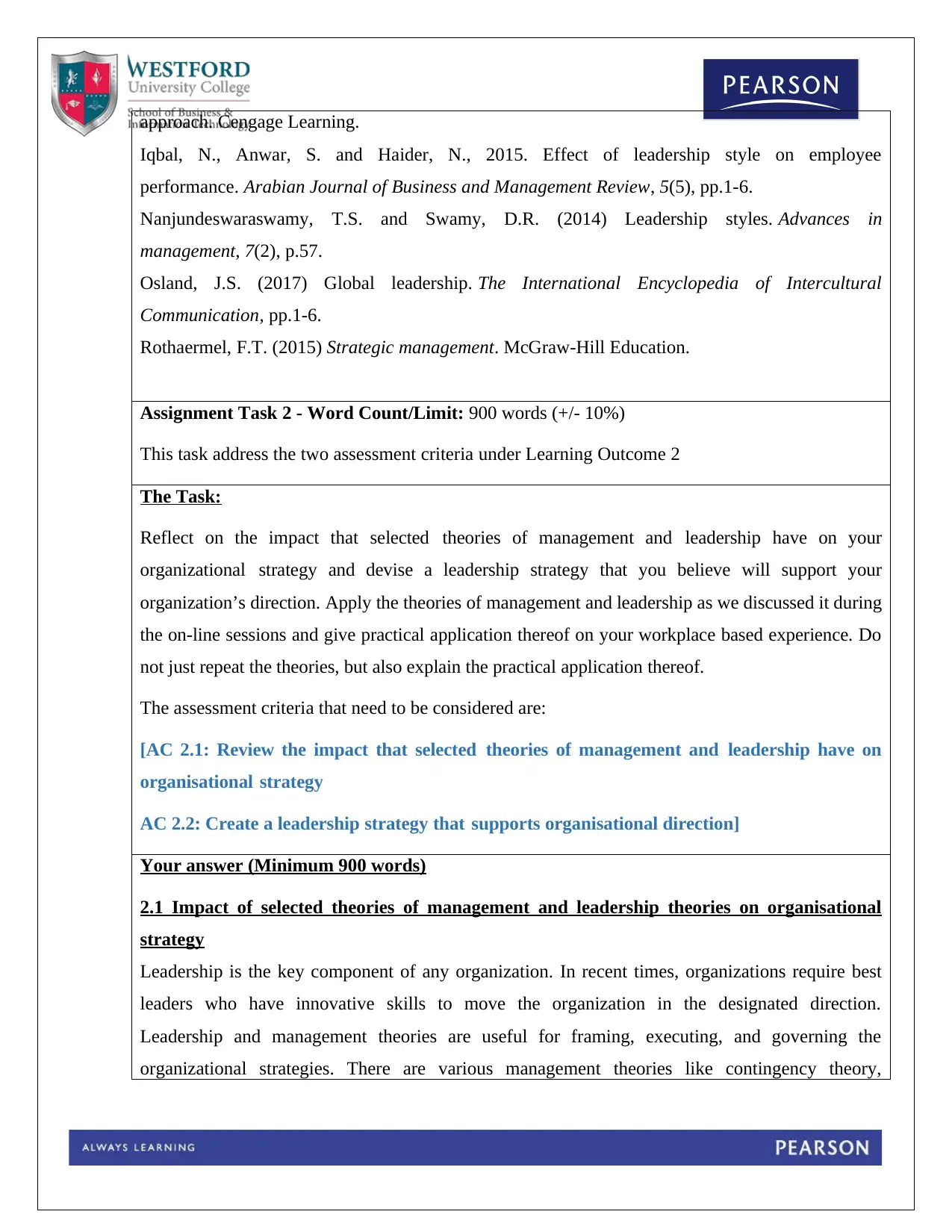
approach. Cengage Learning.
Iqbal, N., Anwar, S. and Haider, N., 2015. Effect of leadership style on employee
performance. Arabian Journal of Business and Management Review, 5(5), pp.1-6.
Nanjundeswaraswamy, T.S. and Swamy, D.R. (2014) Leadership styles. Advances in
management, 7(2), p.57.
Osland, J.S. (2017) Global leadership. The International Encyclopedia of Intercultural
Communication, pp.1-6.
Rothaermel, F.T. (2015) Strategic management. McGraw-Hill Education.
Assignment Task 2 - Word Count/Limit: 900 words (+/- 10%)
This task address the two assessment criteria under Learning Outcome 2
The Task:
Reflect on the impact that selected theories of management and leadership have on your
organizational strategy and devise a leadership strategy that you believe will support your
organization’s direction. Apply the theories of management and leadership as we discussed it during
the on-line sessions and give practical application thereof on your workplace based experience. Do
not just repeat the theories, but also explain the practical application thereof.
The assessment criteria that need to be considered are:
[AC 2.1: Review the impact that selected theories of management and leadership have on
organisational strategy
AC 2.2: Create a leadership strategy that supports organisational direction]
Your answer (Minimum 900 words)
2.1 Impact of selected theories of management and leadership theories on organisational
strategy
Leadership is the key component of any organization. In recent times, organizations require best
leaders who have innovative skills to move the organization in the designated direction.
Leadership and management theories are useful for framing, executing, and governing the
organizational strategies. There are various management theories like contingency theory,
Iqbal, N., Anwar, S. and Haider, N., 2015. Effect of leadership style on employee
performance. Arabian Journal of Business and Management Review, 5(5), pp.1-6.
Nanjundeswaraswamy, T.S. and Swamy, D.R. (2014) Leadership styles. Advances in
management, 7(2), p.57.
Osland, J.S. (2017) Global leadership. The International Encyclopedia of Intercultural
Communication, pp.1-6.
Rothaermel, F.T. (2015) Strategic management. McGraw-Hill Education.
Assignment Task 2 - Word Count/Limit: 900 words (+/- 10%)
This task address the two assessment criteria under Learning Outcome 2
The Task:
Reflect on the impact that selected theories of management and leadership have on your
organizational strategy and devise a leadership strategy that you believe will support your
organization’s direction. Apply the theories of management and leadership as we discussed it during
the on-line sessions and give practical application thereof on your workplace based experience. Do
not just repeat the theories, but also explain the practical application thereof.
The assessment criteria that need to be considered are:
[AC 2.1: Review the impact that selected theories of management and leadership have on
organisational strategy
AC 2.2: Create a leadership strategy that supports organisational direction]
Your answer (Minimum 900 words)
2.1 Impact of selected theories of management and leadership theories on organisational
strategy
Leadership is the key component of any organization. In recent times, organizations require best
leaders who have innovative skills to move the organization in the designated direction.
Leadership and management theories are useful for framing, executing, and governing the
organizational strategies. There are various management theories like contingency theory,
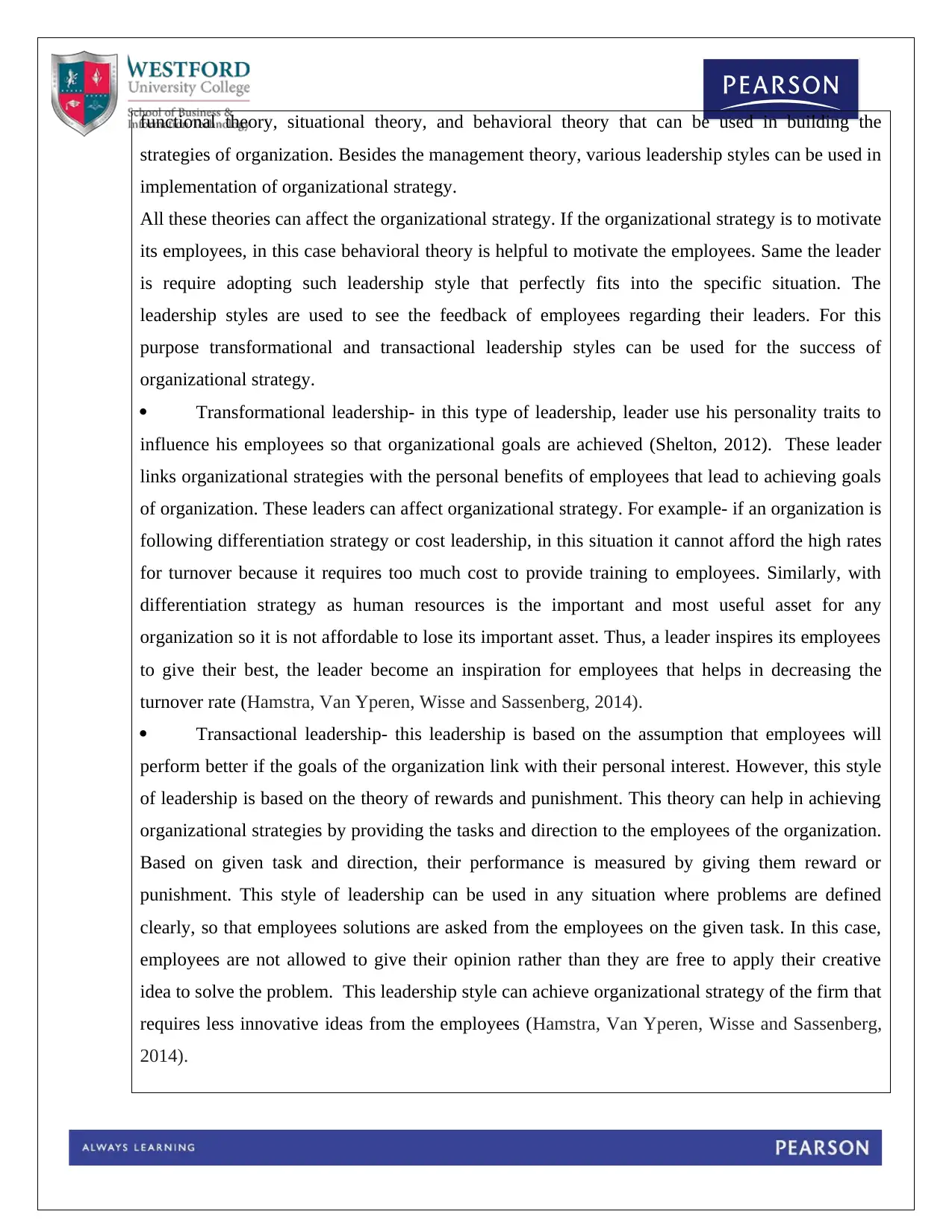
functional theory, situational theory, and behavioral theory that can be used in building the
strategies of organization. Besides the management theory, various leadership styles can be used in
implementation of organizational strategy.
All these theories can affect the organizational strategy. If the organizational strategy is to motivate
its employees, in this case behavioral theory is helpful to motivate the employees. Same the leader
is require adopting such leadership style that perfectly fits into the specific situation. The
leadership styles are used to see the feedback of employees regarding their leaders. For this
purpose transformational and transactional leadership styles can be used for the success of
organizational strategy.
Transformational leadership- in this type of leadership, leader use his personality traits to
influence his employees so that organizational goals are achieved (Shelton, 2012). These leader
links organizational strategies with the personal benefits of employees that lead to achieving goals
of organization. These leaders can affect organizational strategy. For example- if an organization is
following differentiation strategy or cost leadership, in this situation it cannot afford the high rates
for turnover because it requires too much cost to provide training to employees. Similarly, with
differentiation strategy as human resources is the important and most useful asset for any
organization so it is not affordable to lose its important asset. Thus, a leader inspires its employees
to give their best, the leader become an inspiration for employees that helps in decreasing the
turnover rate (Hamstra, Van Yperen, Wisse and Sassenberg, 2014).
Transactional leadership- this leadership is based on the assumption that employees will
perform better if the goals of the organization link with their personal interest. However, this style
of leadership is based on the theory of rewards and punishment. This theory can help in achieving
organizational strategies by providing the tasks and direction to the employees of the organization.
Based on given task and direction, their performance is measured by giving them reward or
punishment. This style of leadership can be used in any situation where problems are defined
clearly, so that employees solutions are asked from the employees on the given task. In this case,
employees are not allowed to give their opinion rather than they are free to apply their creative
idea to solve the problem. This leadership style can achieve organizational strategy of the firm that
requires less innovative ideas from the employees (Hamstra, Van Yperen, Wisse and Sassenberg,
2014).
strategies of organization. Besides the management theory, various leadership styles can be used in
implementation of organizational strategy.
All these theories can affect the organizational strategy. If the organizational strategy is to motivate
its employees, in this case behavioral theory is helpful to motivate the employees. Same the leader
is require adopting such leadership style that perfectly fits into the specific situation. The
leadership styles are used to see the feedback of employees regarding their leaders. For this
purpose transformational and transactional leadership styles can be used for the success of
organizational strategy.
Transformational leadership- in this type of leadership, leader use his personality traits to
influence his employees so that organizational goals are achieved (Shelton, 2012). These leader
links organizational strategies with the personal benefits of employees that lead to achieving goals
of organization. These leaders can affect organizational strategy. For example- if an organization is
following differentiation strategy or cost leadership, in this situation it cannot afford the high rates
for turnover because it requires too much cost to provide training to employees. Similarly, with
differentiation strategy as human resources is the important and most useful asset for any
organization so it is not affordable to lose its important asset. Thus, a leader inspires its employees
to give their best, the leader become an inspiration for employees that helps in decreasing the
turnover rate (Hamstra, Van Yperen, Wisse and Sassenberg, 2014).
Transactional leadership- this leadership is based on the assumption that employees will
perform better if the goals of the organization link with their personal interest. However, this style
of leadership is based on the theory of rewards and punishment. This theory can help in achieving
organizational strategies by providing the tasks and direction to the employees of the organization.
Based on given task and direction, their performance is measured by giving them reward or
punishment. This style of leadership can be used in any situation where problems are defined
clearly, so that employees solutions are asked from the employees on the given task. In this case,
employees are not allowed to give their opinion rather than they are free to apply their creative
idea to solve the problem. This leadership style can achieve organizational strategy of the firm that
requires less innovative ideas from the employees (Hamstra, Van Yperen, Wisse and Sassenberg,
2014).
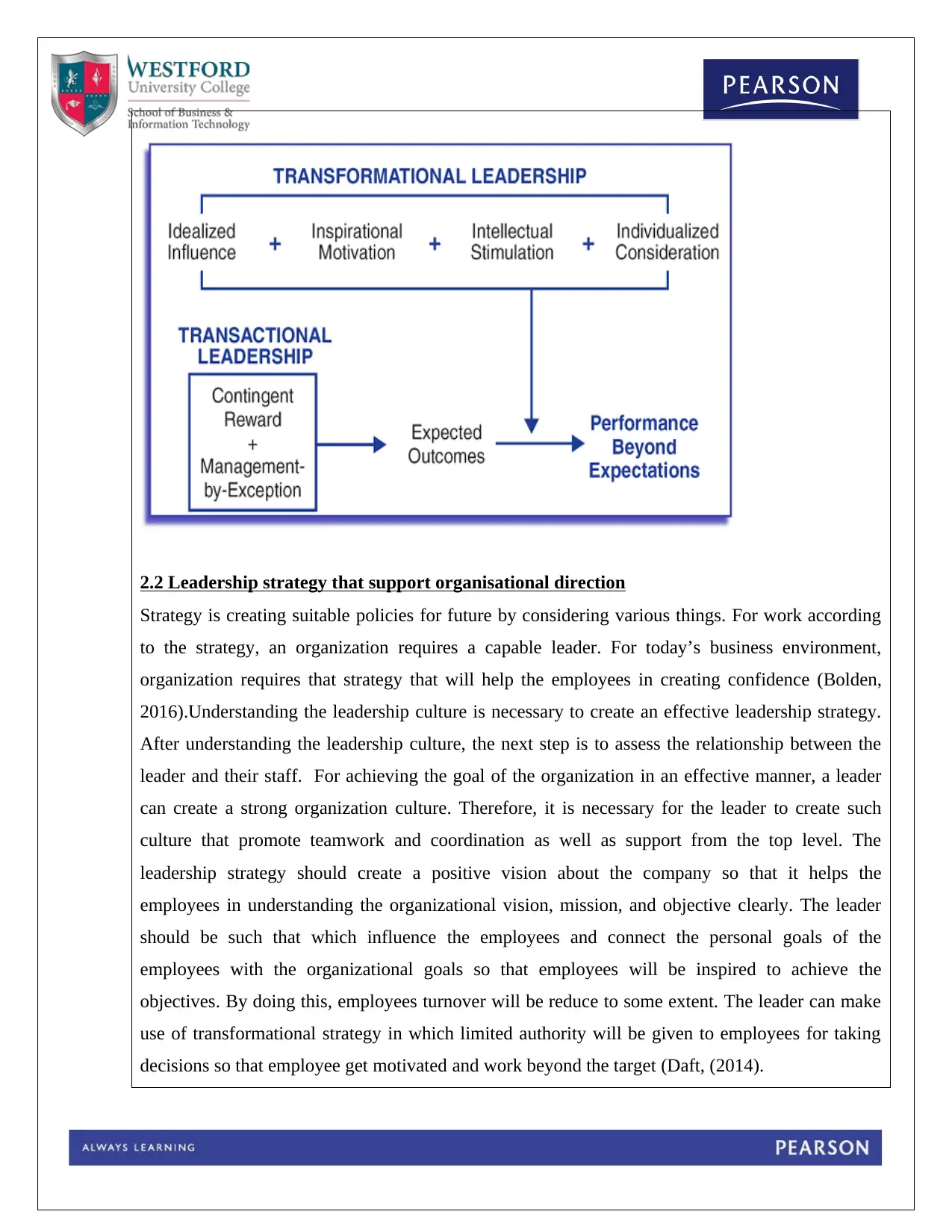
2.2 Leadership strategy that support organisational direction
Strategy is creating suitable policies for future by considering various things. For work according
to the strategy, an organization requires a capable leader. For today’s business environment,
organization requires that strategy that will help the employees in creating confidence (Bolden,
2016).Understanding the leadership culture is necessary to create an effective leadership strategy.
After understanding the leadership culture, the next step is to assess the relationship between the
leader and their staff. For achieving the goal of the organization in an effective manner, a leader
can create a strong organization culture. Therefore, it is necessary for the leader to create such
culture that promote teamwork and coordination as well as support from the top level. The
leadership strategy should create a positive vision about the company so that it helps the
employees in understanding the organizational vision, mission, and objective clearly. The leader
should be such that which influence the employees and connect the personal goals of the
employees with the organizational goals so that employees will be inspired to achieve the
objectives. By doing this, employees turnover will be reduce to some extent. The leader can make
use of transformational strategy in which limited authority will be given to employees for taking
decisions so that employee get motivated and work beyond the target (Daft, (2014).
Strategy is creating suitable policies for future by considering various things. For work according
to the strategy, an organization requires a capable leader. For today’s business environment,
organization requires that strategy that will help the employees in creating confidence (Bolden,
2016).Understanding the leadership culture is necessary to create an effective leadership strategy.
After understanding the leadership culture, the next step is to assess the relationship between the
leader and their staff. For achieving the goal of the organization in an effective manner, a leader
can create a strong organization culture. Therefore, it is necessary for the leader to create such
culture that promote teamwork and coordination as well as support from the top level. The
leadership strategy should create a positive vision about the company so that it helps the
employees in understanding the organizational vision, mission, and objective clearly. The leader
should be such that which influence the employees and connect the personal goals of the
employees with the organizational goals so that employees will be inspired to achieve the
objectives. By doing this, employees turnover will be reduce to some extent. The leader can make
use of transformational strategy in which limited authority will be given to employees for taking
decisions so that employee get motivated and work beyond the target (Daft, (2014).
Secure Best Marks with AI Grader
Need help grading? Try our AI Grader for instant feedback on your assignments.
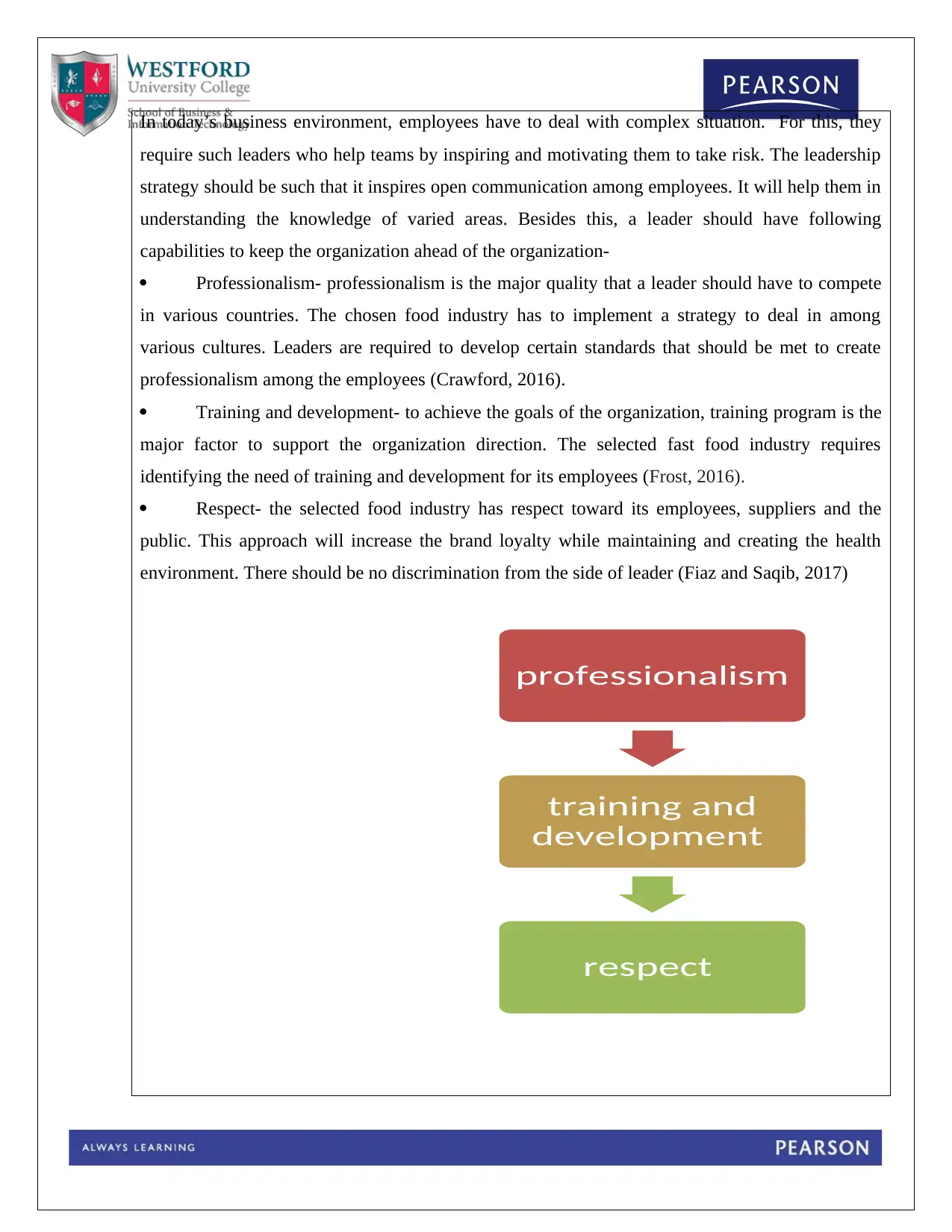
In today’s business environment, employees have to deal with complex situation. For this, they
require such leaders who help teams by inspiring and motivating them to take risk. The leadership
strategy should be such that it inspires open communication among employees. It will help them in
understanding the knowledge of varied areas. Besides this, a leader should have following
capabilities to keep the organization ahead of the organization-
Professionalism- professionalism is the major quality that a leader should have to compete
in various countries. The chosen food industry has to implement a strategy to deal in among
various cultures. Leaders are required to develop certain standards that should be met to create
professionalism among the employees (Crawford, 2016).
Training and development- to achieve the goals of the organization, training program is the
major factor to support the organization direction. The selected fast food industry requires
identifying the need of training and development for its employees (Frost, 2016).
Respect- the selected food industry has respect toward its employees, suppliers and the
public. This approach will increase the brand loyalty while maintaining and creating the health
environment. There should be no discrimination from the side of leader (Fiaz and Saqib, 2017)
professionalism
training and
development
respect
require such leaders who help teams by inspiring and motivating them to take risk. The leadership
strategy should be such that it inspires open communication among employees. It will help them in
understanding the knowledge of varied areas. Besides this, a leader should have following
capabilities to keep the organization ahead of the organization-
Professionalism- professionalism is the major quality that a leader should have to compete
in various countries. The chosen food industry has to implement a strategy to deal in among
various cultures. Leaders are required to develop certain standards that should be met to create
professionalism among the employees (Crawford, 2016).
Training and development- to achieve the goals of the organization, training program is the
major factor to support the organization direction. The selected fast food industry requires
identifying the need of training and development for its employees (Frost, 2016).
Respect- the selected food industry has respect toward its employees, suppliers and the
public. This approach will increase the brand loyalty while maintaining and creating the health
environment. There should be no discrimination from the side of leader (Fiaz and Saqib, 2017)
professionalism
training and
development
respect
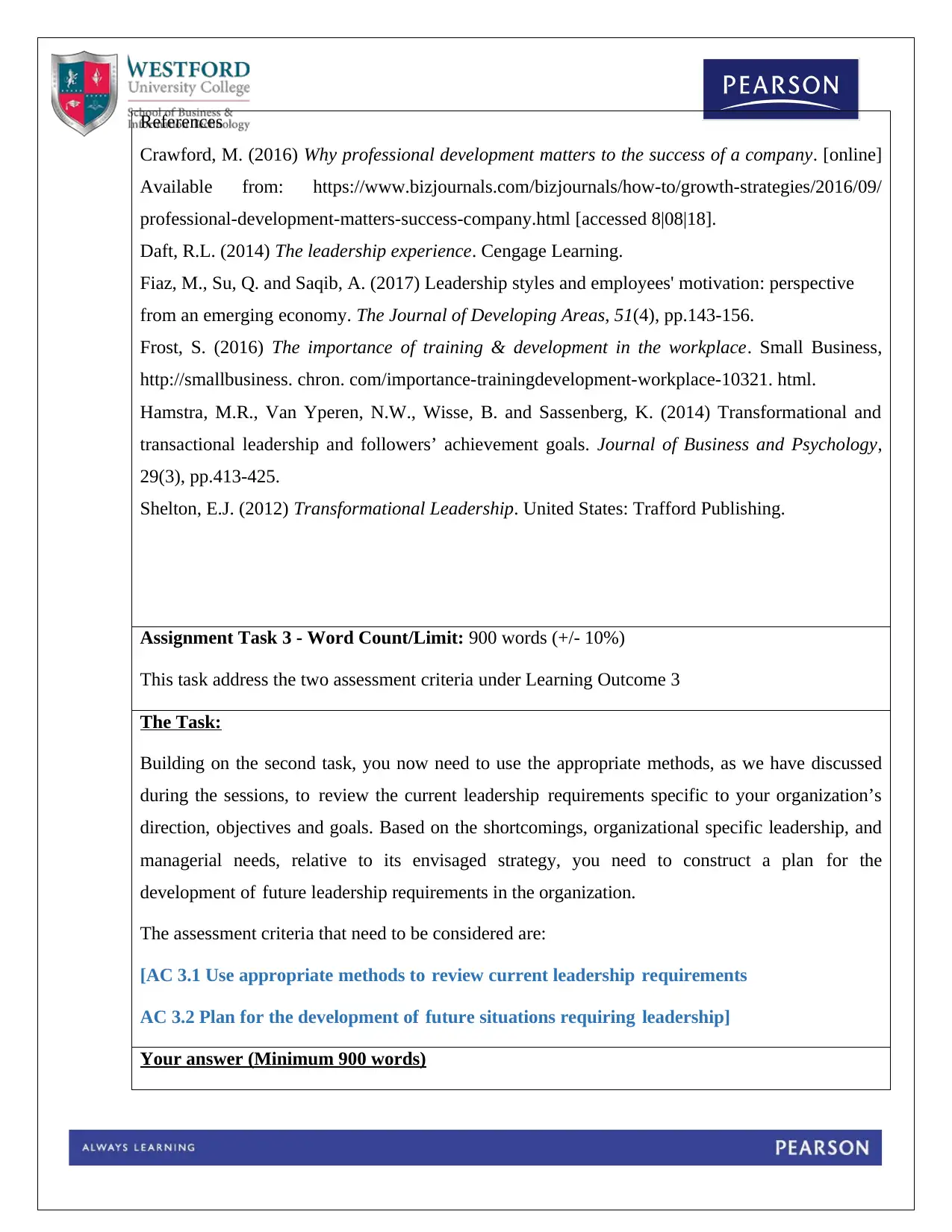
References
Crawford, M. (2016) Why professional development matters to the success of a company. [online]
Available from: https://www.bizjournals.com/bizjournals/how-to/growth-strategies/2016/09/
professional-development-matters-success-company.html [accessed 8|08|18].
Daft, R.L. (2014) The leadership experience. Cengage Learning.
Fiaz, M., Su, Q. and Saqib, A. (2017) Leadership styles and employees' motivation: perspective
from an emerging economy. The Journal of Developing Areas, 51(4), pp.143-156.
Frost, S. (2016) The importance of training & development in the workplace. Small Business,
http://smallbusiness. chron. com/importance-trainingdevelopment-workplace-10321. html.
Hamstra, M.R., Van Yperen, N.W., Wisse, B. and Sassenberg, K. (2014) Transformational and
transactional leadership and followers’ achievement goals. Journal of Business and Psychology,
29(3), pp.413-425.
Shelton, E.J. (2012) Transformational Leadership. United States: Trafford Publishing.
Assignment Task 3 - Word Count/Limit: 900 words (+/- 10%)
This task address the two assessment criteria under Learning Outcome 3
The Task:
Building on the second task, you now need to use the appropriate methods, as we have discussed
during the sessions, to review the current leadership requirements specific to your organization’s
direction, objectives and goals. Based on the shortcomings, organizational specific leadership, and
managerial needs, relative to its envisaged strategy, you need to construct a plan for the
development of future leadership requirements in the organization.
The assessment criteria that need to be considered are:
[AC 3.1 Use appropriate methods to review current leadership requirements
AC 3.2 Plan for the development of future situations requiring leadership]
Your answer (Minimum 900 words)
Crawford, M. (2016) Why professional development matters to the success of a company. [online]
Available from: https://www.bizjournals.com/bizjournals/how-to/growth-strategies/2016/09/
professional-development-matters-success-company.html [accessed 8|08|18].
Daft, R.L. (2014) The leadership experience. Cengage Learning.
Fiaz, M., Su, Q. and Saqib, A. (2017) Leadership styles and employees' motivation: perspective
from an emerging economy. The Journal of Developing Areas, 51(4), pp.143-156.
Frost, S. (2016) The importance of training & development in the workplace. Small Business,
http://smallbusiness. chron. com/importance-trainingdevelopment-workplace-10321. html.
Hamstra, M.R., Van Yperen, N.W., Wisse, B. and Sassenberg, K. (2014) Transformational and
transactional leadership and followers’ achievement goals. Journal of Business and Psychology,
29(3), pp.413-425.
Shelton, E.J. (2012) Transformational Leadership. United States: Trafford Publishing.
Assignment Task 3 - Word Count/Limit: 900 words (+/- 10%)
This task address the two assessment criteria under Learning Outcome 3
The Task:
Building on the second task, you now need to use the appropriate methods, as we have discussed
during the sessions, to review the current leadership requirements specific to your organization’s
direction, objectives and goals. Based on the shortcomings, organizational specific leadership, and
managerial needs, relative to its envisaged strategy, you need to construct a plan for the
development of future leadership requirements in the organization.
The assessment criteria that need to be considered are:
[AC 3.1 Use appropriate methods to review current leadership requirements
AC 3.2 Plan for the development of future situations requiring leadership]
Your answer (Minimum 900 words)
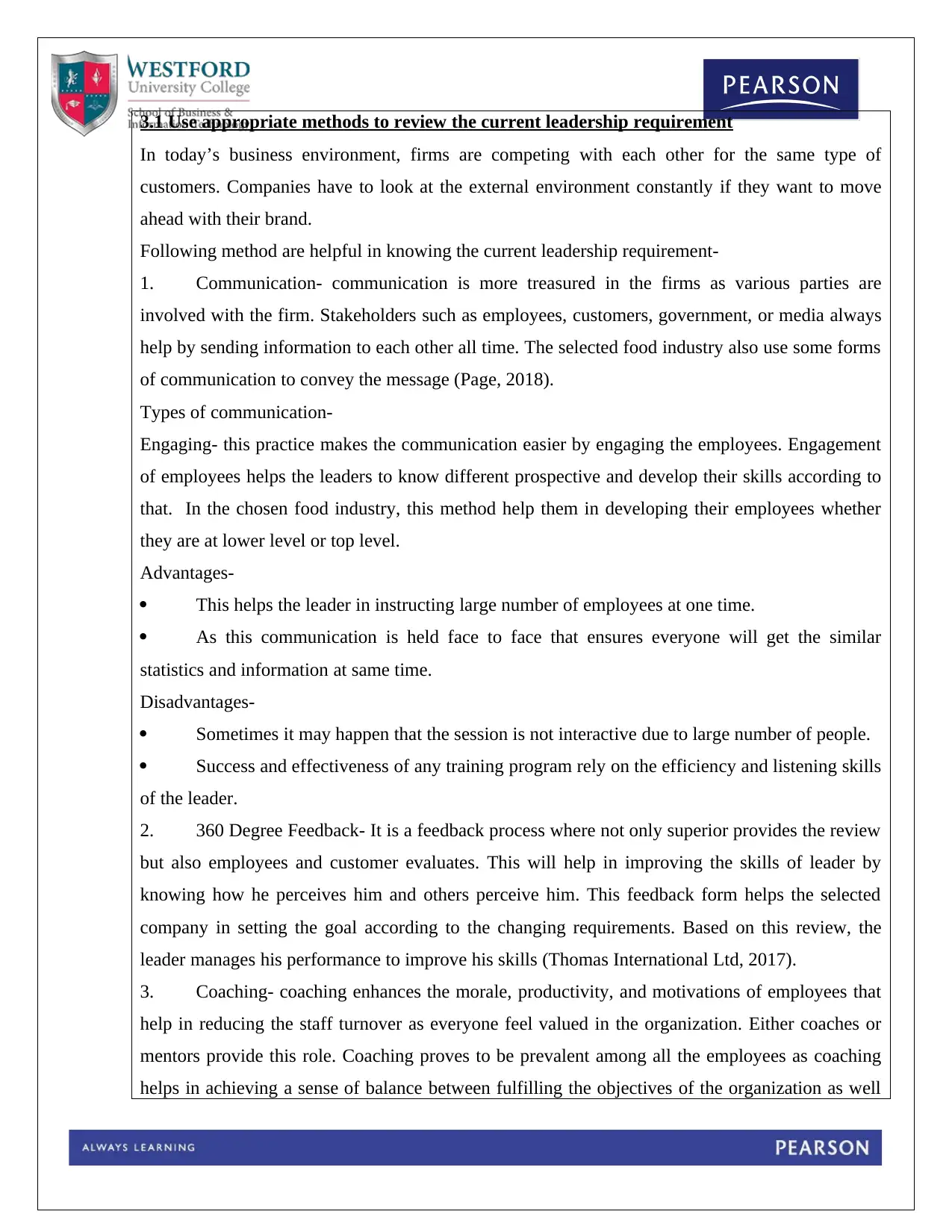
3.1 Use appropriate methods to review the current leadership requirement
In today’s business environment, firms are competing with each other for the same type of
customers. Companies have to look at the external environment constantly if they want to move
ahead with their brand.
Following method are helpful in knowing the current leadership requirement-
1. Communication- communication is more treasured in the firms as various parties are
involved with the firm. Stakeholders such as employees, customers, government, or media always
help by sending information to each other all time. The selected food industry also use some forms
of communication to convey the message (Page, 2018).
Types of communication-
Engaging- this practice makes the communication easier by engaging the employees. Engagement
of employees helps the leaders to know different prospective and develop their skills according to
that. In the chosen food industry, this method help them in developing their employees whether
they are at lower level or top level.
Advantages-
This helps the leader in instructing large number of employees at one time.
As this communication is held face to face that ensures everyone will get the similar
statistics and information at same time.
Disadvantages-
Sometimes it may happen that the session is not interactive due to large number of people.
Success and effectiveness of any training program rely on the efficiency and listening skills
of the leader.
2. 360 Degree Feedback- It is a feedback process where not only superior provides the review
but also employees and customer evaluates. This will help in improving the skills of leader by
knowing how he perceives him and others perceive him. This feedback form helps the selected
company in setting the goal according to the changing requirements. Based on this review, the
leader manages his performance to improve his skills (Thomas International Ltd, 2017).
3. Coaching- coaching enhances the morale, productivity, and motivations of employees that
help in reducing the staff turnover as everyone feel valued in the organization. Either coaches or
mentors provide this role. Coaching proves to be prevalent among all the employees as coaching
helps in achieving a sense of balance between fulfilling the objectives of the organization as well
In today’s business environment, firms are competing with each other for the same type of
customers. Companies have to look at the external environment constantly if they want to move
ahead with their brand.
Following method are helpful in knowing the current leadership requirement-
1. Communication- communication is more treasured in the firms as various parties are
involved with the firm. Stakeholders such as employees, customers, government, or media always
help by sending information to each other all time. The selected food industry also use some forms
of communication to convey the message (Page, 2018).
Types of communication-
Engaging- this practice makes the communication easier by engaging the employees. Engagement
of employees helps the leaders to know different prospective and develop their skills according to
that. In the chosen food industry, this method help them in developing their employees whether
they are at lower level or top level.
Advantages-
This helps the leader in instructing large number of employees at one time.
As this communication is held face to face that ensures everyone will get the similar
statistics and information at same time.
Disadvantages-
Sometimes it may happen that the session is not interactive due to large number of people.
Success and effectiveness of any training program rely on the efficiency and listening skills
of the leader.
2. 360 Degree Feedback- It is a feedback process where not only superior provides the review
but also employees and customer evaluates. This will help in improving the skills of leader by
knowing how he perceives him and others perceive him. This feedback form helps the selected
company in setting the goal according to the changing requirements. Based on this review, the
leader manages his performance to improve his skills (Thomas International Ltd, 2017).
3. Coaching- coaching enhances the morale, productivity, and motivations of employees that
help in reducing the staff turnover as everyone feel valued in the organization. Either coaches or
mentors provide this role. Coaching proves to be prevalent among all the employees as coaching
helps in achieving a sense of balance between fulfilling the objectives of the organization as well
Paraphrase This Document
Need a fresh take? Get an instant paraphrase of this document with our AI Paraphraser
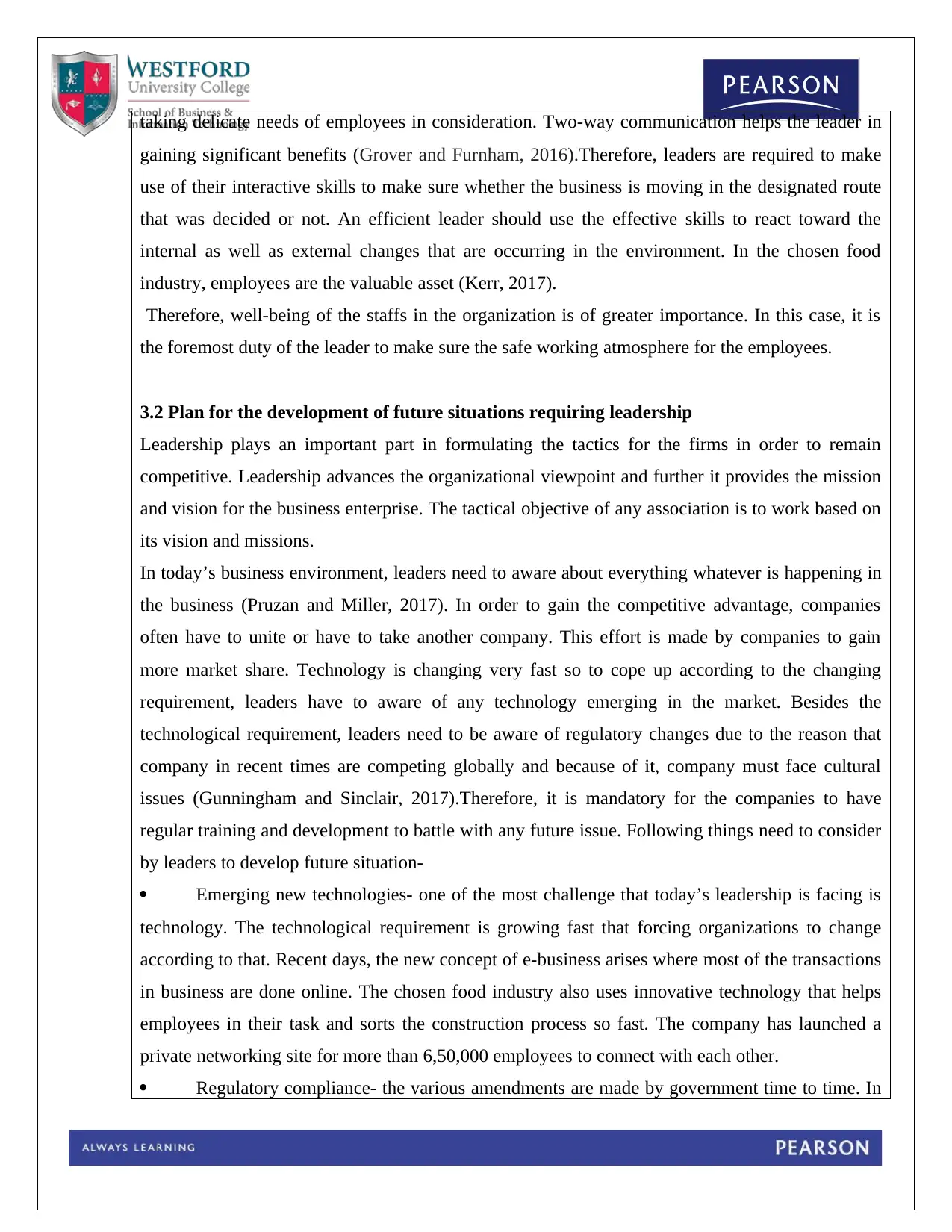
taking delicate needs of employees in consideration. Two-way communication helps the leader in
gaining significant benefits (Grover and Furnham, 2016).Therefore, leaders are required to make
use of their interactive skills to make sure whether the business is moving in the designated route
that was decided or not. An efficient leader should use the effective skills to react toward the
internal as well as external changes that are occurring in the environment. In the chosen food
industry, employees are the valuable asset (Kerr, 2017).
Therefore, well-being of the staffs in the organization is of greater importance. In this case, it is
the foremost duty of the leader to make sure the safe working atmosphere for the employees.
3.2 Plan for the development of future situations requiring leadership
Leadership plays an important part in formulating the tactics for the firms in order to remain
competitive. Leadership advances the organizational viewpoint and further it provides the mission
and vision for the business enterprise. The tactical objective of any association is to work based on
its vision and missions.
In today’s business environment, leaders need to aware about everything whatever is happening in
the business (Pruzan and Miller, 2017). In order to gain the competitive advantage, companies
often have to unite or have to take another company. This effort is made by companies to gain
more market share. Technology is changing very fast so to cope up according to the changing
requirement, leaders have to aware of any technology emerging in the market. Besides the
technological requirement, leaders need to be aware of regulatory changes due to the reason that
company in recent times are competing globally and because of it, company must face cultural
issues (Gunningham and Sinclair, 2017).Therefore, it is mandatory for the companies to have
regular training and development to battle with any future issue. Following things need to consider
by leaders to develop future situation-
Emerging new technologies- one of the most challenge that today’s leadership is facing is
technology. The technological requirement is growing fast that forcing organizations to change
according to that. Recent days, the new concept of e-business arises where most of the transactions
in business are done online. The chosen food industry also uses innovative technology that helps
employees in their task and sorts the construction process so fast. The company has launched a
private networking site for more than 6,50,000 employees to connect with each other.
Regulatory compliance- the various amendments are made by government time to time. In
gaining significant benefits (Grover and Furnham, 2016).Therefore, leaders are required to make
use of their interactive skills to make sure whether the business is moving in the designated route
that was decided or not. An efficient leader should use the effective skills to react toward the
internal as well as external changes that are occurring in the environment. In the chosen food
industry, employees are the valuable asset (Kerr, 2017).
Therefore, well-being of the staffs in the organization is of greater importance. In this case, it is
the foremost duty of the leader to make sure the safe working atmosphere for the employees.
3.2 Plan for the development of future situations requiring leadership
Leadership plays an important part in formulating the tactics for the firms in order to remain
competitive. Leadership advances the organizational viewpoint and further it provides the mission
and vision for the business enterprise. The tactical objective of any association is to work based on
its vision and missions.
In today’s business environment, leaders need to aware about everything whatever is happening in
the business (Pruzan and Miller, 2017). In order to gain the competitive advantage, companies
often have to unite or have to take another company. This effort is made by companies to gain
more market share. Technology is changing very fast so to cope up according to the changing
requirement, leaders have to aware of any technology emerging in the market. Besides the
technological requirement, leaders need to be aware of regulatory changes due to the reason that
company in recent times are competing globally and because of it, company must face cultural
issues (Gunningham and Sinclair, 2017).Therefore, it is mandatory for the companies to have
regular training and development to battle with any future issue. Following things need to consider
by leaders to develop future situation-
Emerging new technologies- one of the most challenge that today’s leadership is facing is
technology. The technological requirement is growing fast that forcing organizations to change
according to that. Recent days, the new concept of e-business arises where most of the transactions
in business are done online. The chosen food industry also uses innovative technology that helps
employees in their task and sorts the construction process so fast. The company has launched a
private networking site for more than 6,50,000 employees to connect with each other.
Regulatory compliance- the various amendments are made by government time to time. In
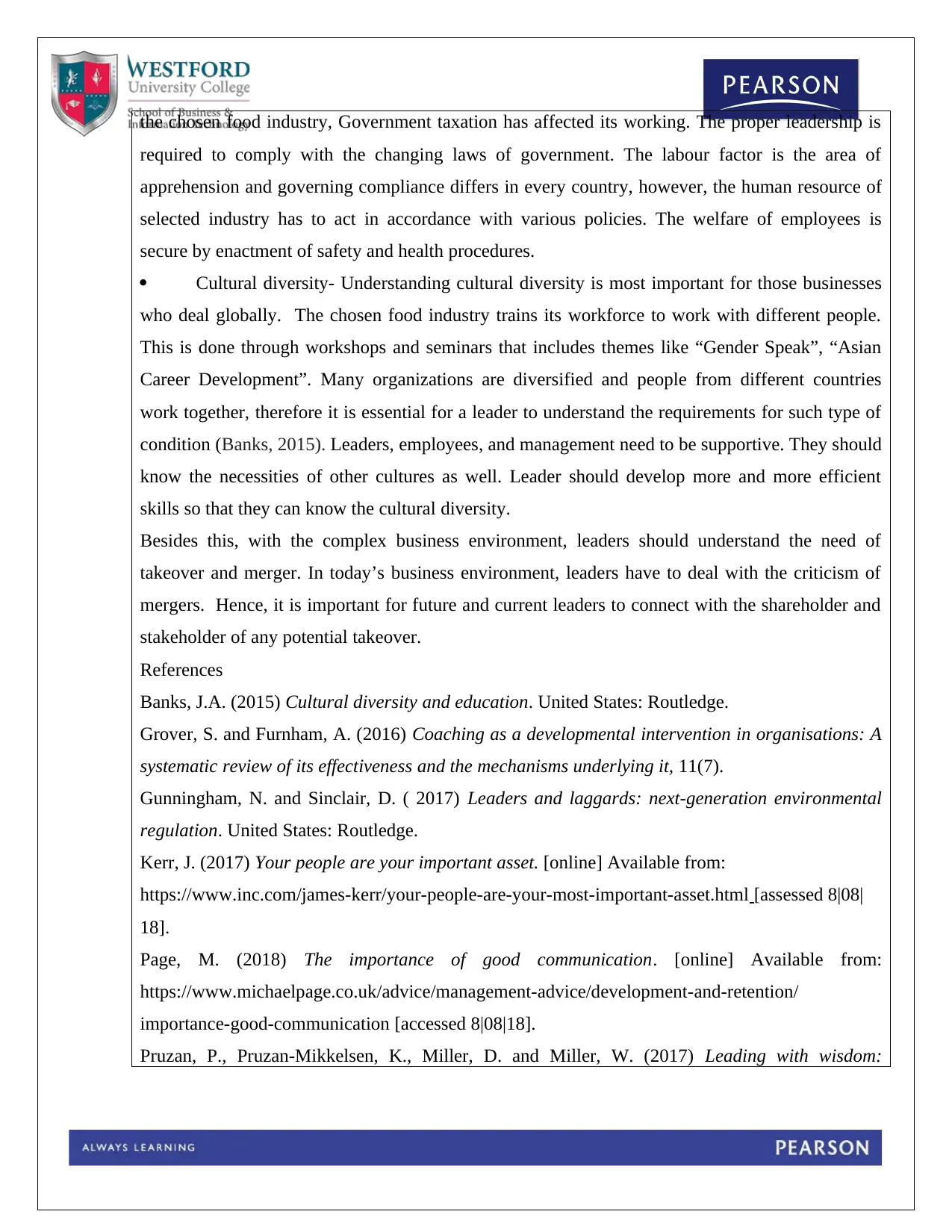
the chosen food industry, Government taxation has affected its working. The proper leadership is
required to comply with the changing laws of government. The labour factor is the area of
apprehension and governing compliance differs in every country, however, the human resource of
selected industry has to act in accordance with various policies. The welfare of employees is
secure by enactment of safety and health procedures.
Cultural diversity- Understanding cultural diversity is most important for those businesses
who deal globally. The chosen food industry trains its workforce to work with different people.
This is done through workshops and seminars that includes themes like “Gender Speak”, “Asian
Career Development”. Many organizations are diversified and people from different countries
work together, therefore it is essential for a leader to understand the requirements for such type of
condition (Banks, 2015). Leaders, employees, and management need to be supportive. They should
know the necessities of other cultures as well. Leader should develop more and more efficient
skills so that they can know the cultural diversity.
Besides this, with the complex business environment, leaders should understand the need of
takeover and merger. In today’s business environment, leaders have to deal with the criticism of
mergers. Hence, it is important for future and current leaders to connect with the shareholder and
stakeholder of any potential takeover.
References
Banks, J.A. (2015) Cultural diversity and education. United States: Routledge.
Grover, S. and Furnham, A. (2016) Coaching as a developmental intervention in organisations: A
systematic review of its effectiveness and the mechanisms underlying it, 11(7).
Gunningham, N. and Sinclair, D. ( 2017) Leaders and laggards: next-generation environmental
regulation. United States: Routledge.
Kerr, J. (2017) Your people are your important asset. [online] Available from:
https://www.inc.com/james-kerr/your-people-are-your-most-important-asset.html [assessed 8|08|
18].
Page, M. (2018) The importance of good communication. [online] Available from:
https://www.michaelpage.co.uk/advice/management-advice/development-and-retention/
importance-good-communication [accessed 8|08|18].
Pruzan, P., Pruzan-Mikkelsen, K., Miller, D. and Miller, W. (2017) Leading with wisdom:
required to comply with the changing laws of government. The labour factor is the area of
apprehension and governing compliance differs in every country, however, the human resource of
selected industry has to act in accordance with various policies. The welfare of employees is
secure by enactment of safety and health procedures.
Cultural diversity- Understanding cultural diversity is most important for those businesses
who deal globally. The chosen food industry trains its workforce to work with different people.
This is done through workshops and seminars that includes themes like “Gender Speak”, “Asian
Career Development”. Many organizations are diversified and people from different countries
work together, therefore it is essential for a leader to understand the requirements for such type of
condition (Banks, 2015). Leaders, employees, and management need to be supportive. They should
know the necessities of other cultures as well. Leader should develop more and more efficient
skills so that they can know the cultural diversity.
Besides this, with the complex business environment, leaders should understand the need of
takeover and merger. In today’s business environment, leaders have to deal with the criticism of
mergers. Hence, it is important for future and current leaders to connect with the shareholder and
stakeholder of any potential takeover.
References
Banks, J.A. (2015) Cultural diversity and education. United States: Routledge.
Grover, S. and Furnham, A. (2016) Coaching as a developmental intervention in organisations: A
systematic review of its effectiveness and the mechanisms underlying it, 11(7).
Gunningham, N. and Sinclair, D. ( 2017) Leaders and laggards: next-generation environmental
regulation. United States: Routledge.
Kerr, J. (2017) Your people are your important asset. [online] Available from:
https://www.inc.com/james-kerr/your-people-are-your-most-important-asset.html [assessed 8|08|
18].
Page, M. (2018) The importance of good communication. [online] Available from:
https://www.michaelpage.co.uk/advice/management-advice/development-and-retention/
importance-good-communication [accessed 8|08|18].
Pruzan, P., Pruzan-Mikkelsen, K., Miller, D. and Miller, W. (2017) Leading with wisdom:

Spiritual-based leadership in business. United States: Routledge.
Thomas International Ltd (2017) 360 Degree Feedback. [online] Available from:
https://www.thomasinternational.net/en-in/assessments/assessments-by-type/360-degree-feedback/
[accessed 8|08|18].
Assignment Task 4 - Word Count/Limit: 900 words (+/- 10%)
This task address the two assessment criteria under Learning Outcome 4
The Task:
In conclusion of the assignment, reflect and report on how useful the methods are that you used in
Task 3 to plan the development of leadership skills that is required for the specific strategic
direction of your organization.
The assessment criteria that need to be considered are:
[AC 4.1 Plan the development of leadership skills for a specific requirement
AC 4.2 Report on the usefulness of methods used to plan the development of leadership
skills]
Thomas International Ltd (2017) 360 Degree Feedback. [online] Available from:
https://www.thomasinternational.net/en-in/assessments/assessments-by-type/360-degree-feedback/
[accessed 8|08|18].
Assignment Task 4 - Word Count/Limit: 900 words (+/- 10%)
This task address the two assessment criteria under Learning Outcome 4
The Task:
In conclusion of the assignment, reflect and report on how useful the methods are that you used in
Task 3 to plan the development of leadership skills that is required for the specific strategic
direction of your organization.
The assessment criteria that need to be considered are:
[AC 4.1 Plan the development of leadership skills for a specific requirement
AC 4.2 Report on the usefulness of methods used to plan the development of leadership
skills]
Secure Best Marks with AI Grader
Need help grading? Try our AI Grader for instant feedback on your assignments.
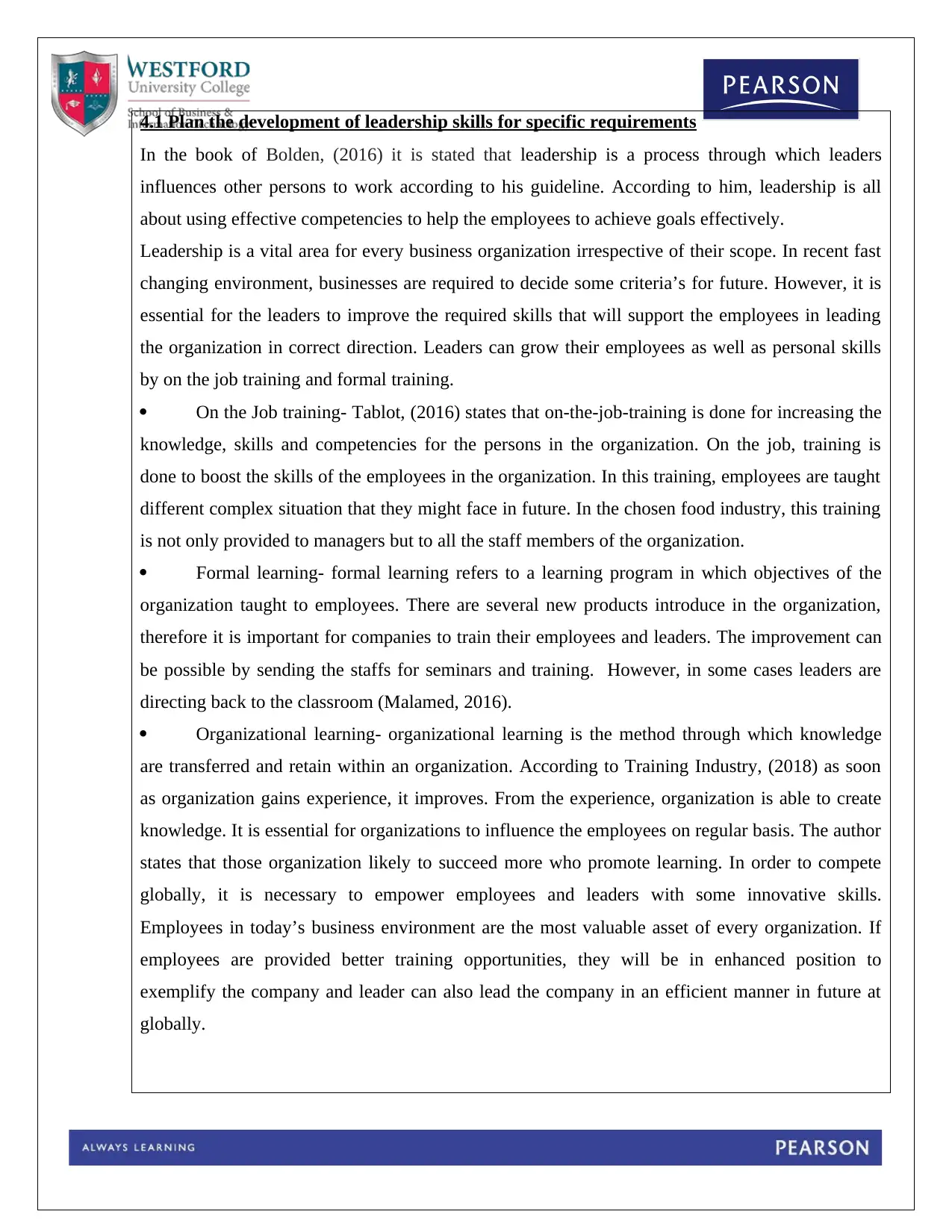
4.1 Plan the development of leadership skills for specific requirements
In the book of Bolden, (2016) it is stated that leadership is a process through which leaders
influences other persons to work according to his guideline. According to him, leadership is all
about using effective competencies to help the employees to achieve goals effectively.
Leadership is a vital area for every business organization irrespective of their scope. In recent fast
changing environment, businesses are required to decide some criteria’s for future. However, it is
essential for the leaders to improve the required skills that will support the employees in leading
the organization in correct direction. Leaders can grow their employees as well as personal skills
by on the job training and formal training.
On the Job training- Tablot, (2016) states that on-the-job-training is done for increasing the
knowledge, skills and competencies for the persons in the organization. On the job, training is
done to boost the skills of the employees in the organization. In this training, employees are taught
different complex situation that they might face in future. In the chosen food industry, this training
is not only provided to managers but to all the staff members of the organization.
Formal learning- formal learning refers to a learning program in which objectives of the
organization taught to employees. There are several new products introduce in the organization,
therefore it is important for companies to train their employees and leaders. The improvement can
be possible by sending the staffs for seminars and training. However, in some cases leaders are
directing back to the classroom (Malamed, 2016).
Organizational learning- organizational learning is the method through which knowledge
are transferred and retain within an organization. According to Training Industry, (2018) as soon
as organization gains experience, it improves. From the experience, organization is able to create
knowledge. It is essential for organizations to influence the employees on regular basis. The author
states that those organization likely to succeed more who promote learning. In order to compete
globally, it is necessary to empower employees and leaders with some innovative skills.
Employees in today’s business environment are the most valuable asset of every organization. If
employees are provided better training opportunities, they will be in enhanced position to
exemplify the company and leader can also lead the company in an efficient manner in future at
globally.
In the book of Bolden, (2016) it is stated that leadership is a process through which leaders
influences other persons to work according to his guideline. According to him, leadership is all
about using effective competencies to help the employees to achieve goals effectively.
Leadership is a vital area for every business organization irrespective of their scope. In recent fast
changing environment, businesses are required to decide some criteria’s for future. However, it is
essential for the leaders to improve the required skills that will support the employees in leading
the organization in correct direction. Leaders can grow their employees as well as personal skills
by on the job training and formal training.
On the Job training- Tablot, (2016) states that on-the-job-training is done for increasing the
knowledge, skills and competencies for the persons in the organization. On the job, training is
done to boost the skills of the employees in the organization. In this training, employees are taught
different complex situation that they might face in future. In the chosen food industry, this training
is not only provided to managers but to all the staff members of the organization.
Formal learning- formal learning refers to a learning program in which objectives of the
organization taught to employees. There are several new products introduce in the organization,
therefore it is important for companies to train their employees and leaders. The improvement can
be possible by sending the staffs for seminars and training. However, in some cases leaders are
directing back to the classroom (Malamed, 2016).
Organizational learning- organizational learning is the method through which knowledge
are transferred and retain within an organization. According to Training Industry, (2018) as soon
as organization gains experience, it improves. From the experience, organization is able to create
knowledge. It is essential for organizations to influence the employees on regular basis. The author
states that those organization likely to succeed more who promote learning. In order to compete
globally, it is necessary to empower employees and leaders with some innovative skills.
Employees in today’s business environment are the most valuable asset of every organization. If
employees are provided better training opportunities, they will be in enhanced position to
exemplify the company and leader can also lead the company in an efficient manner in future at
globally.
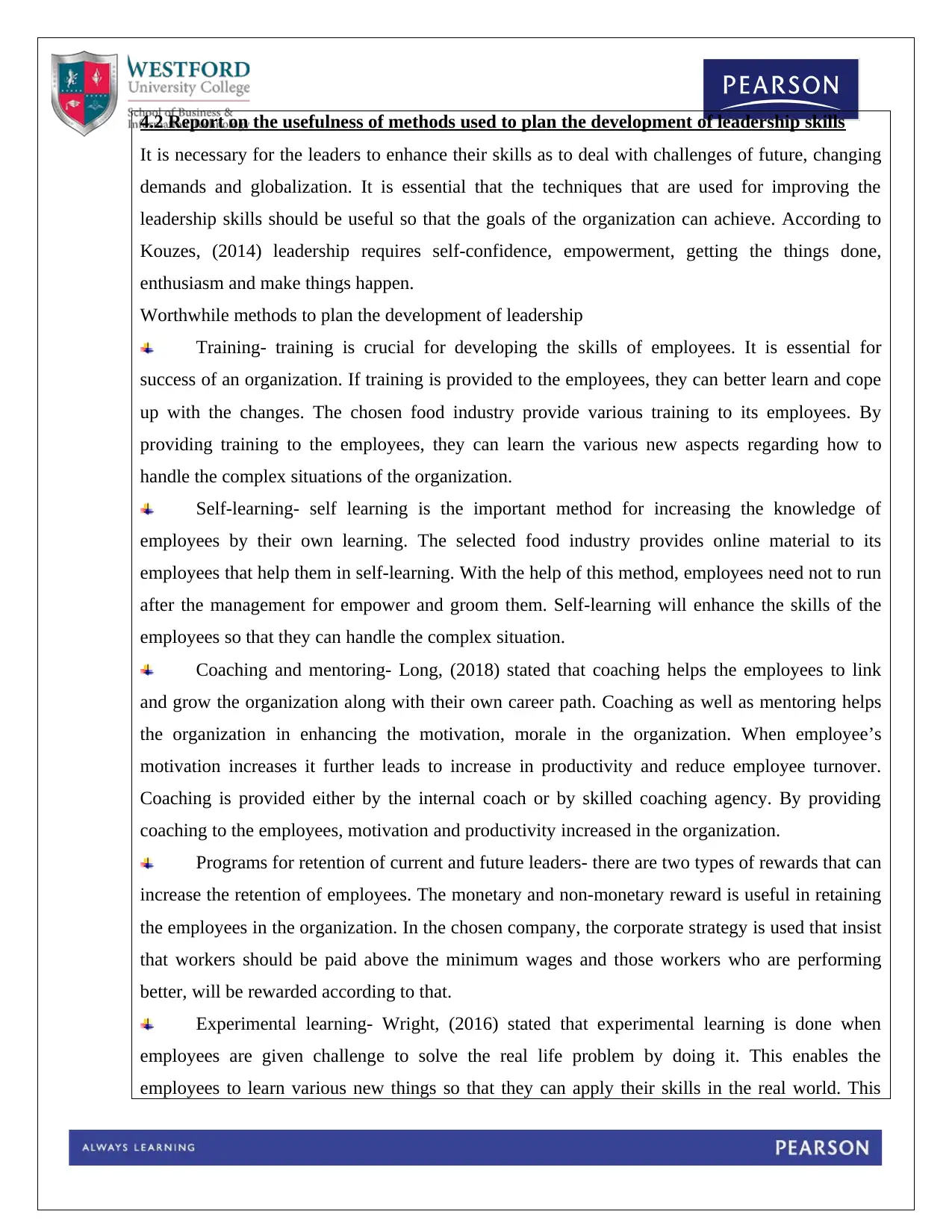
4.2 Report on the usefulness of methods used to plan the development of leadership skills
It is necessary for the leaders to enhance their skills as to deal with challenges of future, changing
demands and globalization. It is essential that the techniques that are used for improving the
leadership skills should be useful so that the goals of the organization can achieve. According to
Kouzes, (2014) leadership requires self-confidence, empowerment, getting the things done,
enthusiasm and make things happen.
Worthwhile methods to plan the development of leadership
Training- training is crucial for developing the skills of employees. It is essential for
success of an organization. If training is provided to the employees, they can better learn and cope
up with the changes. The chosen food industry provide various training to its employees. By
providing training to the employees, they can learn the various new aspects regarding how to
handle the complex situations of the organization.
Self-learning- self learning is the important method for increasing the knowledge of
employees by their own learning. The selected food industry provides online material to its
employees that help them in self-learning. With the help of this method, employees need not to run
after the management for empower and groom them. Self-learning will enhance the skills of the
employees so that they can handle the complex situation.
Coaching and mentoring- Long, (2018) stated that coaching helps the employees to link
and grow the organization along with their own career path. Coaching as well as mentoring helps
the organization in enhancing the motivation, morale in the organization. When employee’s
motivation increases it further leads to increase in productivity and reduce employee turnover.
Coaching is provided either by the internal coach or by skilled coaching agency. By providing
coaching to the employees, motivation and productivity increased in the organization.
Programs for retention of current and future leaders- there are two types of rewards that can
increase the retention of employees. The monetary and non-monetary reward is useful in retaining
the employees in the organization. In the chosen company, the corporate strategy is used that insist
that workers should be paid above the minimum wages and those workers who are performing
better, will be rewarded according to that.
Experimental learning- Wright, (2016) stated that experimental learning is done when
employees are given challenge to solve the real life problem by doing it. This enables the
employees to learn various new things so that they can apply their skills in the real world. This
It is necessary for the leaders to enhance their skills as to deal with challenges of future, changing
demands and globalization. It is essential that the techniques that are used for improving the
leadership skills should be useful so that the goals of the organization can achieve. According to
Kouzes, (2014) leadership requires self-confidence, empowerment, getting the things done,
enthusiasm and make things happen.
Worthwhile methods to plan the development of leadership
Training- training is crucial for developing the skills of employees. It is essential for
success of an organization. If training is provided to the employees, they can better learn and cope
up with the changes. The chosen food industry provide various training to its employees. By
providing training to the employees, they can learn the various new aspects regarding how to
handle the complex situations of the organization.
Self-learning- self learning is the important method for increasing the knowledge of
employees by their own learning. The selected food industry provides online material to its
employees that help them in self-learning. With the help of this method, employees need not to run
after the management for empower and groom them. Self-learning will enhance the skills of the
employees so that they can handle the complex situation.
Coaching and mentoring- Long, (2018) stated that coaching helps the employees to link
and grow the organization along with their own career path. Coaching as well as mentoring helps
the organization in enhancing the motivation, morale in the organization. When employee’s
motivation increases it further leads to increase in productivity and reduce employee turnover.
Coaching is provided either by the internal coach or by skilled coaching agency. By providing
coaching to the employees, motivation and productivity increased in the organization.
Programs for retention of current and future leaders- there are two types of rewards that can
increase the retention of employees. The monetary and non-monetary reward is useful in retaining
the employees in the organization. In the chosen company, the corporate strategy is used that insist
that workers should be paid above the minimum wages and those workers who are performing
better, will be rewarded according to that.
Experimental learning- Wright, (2016) stated that experimental learning is done when
employees are given challenge to solve the real life problem by doing it. This enables the
employees to learn various new things so that they can apply their skills in the real world. This
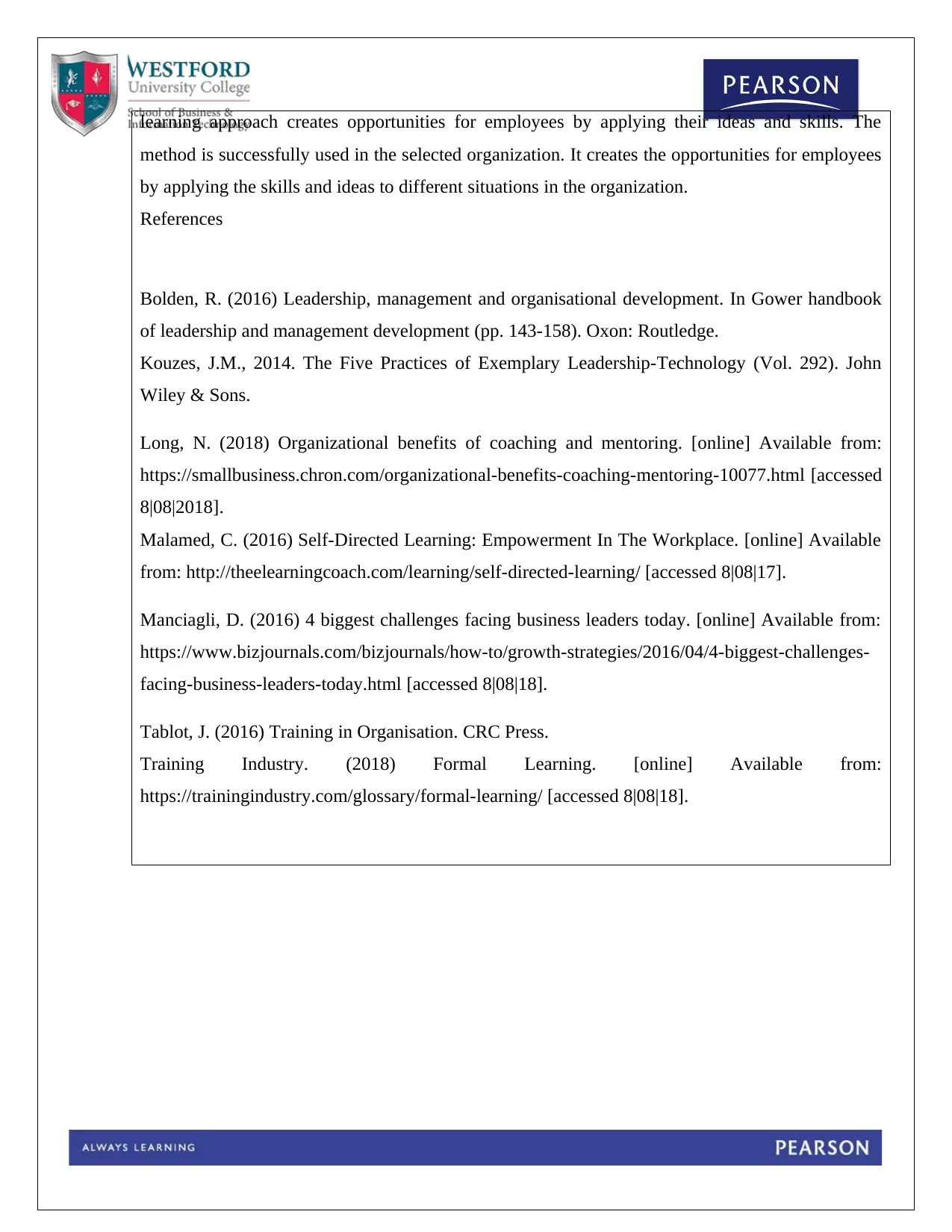
learning approach creates opportunities for employees by applying their ideas and skills. The
method is successfully used in the selected organization. It creates the opportunities for employees
by applying the skills and ideas to different situations in the organization.
References
Bolden, R. (2016) Leadership, management and organisational development. In Gower handbook
of leadership and management development (pp. 143-158). Oxon: Routledge.
Kouzes, J.M., 2014. The Five Practices of Exemplary Leadership-Technology (Vol. 292). John
Wiley & Sons.
Long, N. (2018) Organizational benefits of coaching and mentoring. [online] Available from:
https://smallbusiness.chron.com/organizational-benefits-coaching-mentoring-10077.html [accessed
8|08|2018].
Malamed, C. (2016) Self-Directed Learning: Empowerment In The Workplace. [online] Available
from: http://theelearningcoach.com/learning/self-directed-learning/ [accessed 8|08|17].
Manciagli, D. (2016) 4 biggest challenges facing business leaders today. [online] Available from:
https://www.bizjournals.com/bizjournals/how-to/growth-strategies/2016/04/4-biggest-challenges-
facing-business-leaders-today.html [accessed 8|08|18].
Tablot, J. (2016) Training in Organisation. CRC Press.
Training Industry. (2018) Formal Learning. [online] Available from:
https://trainingindustry.com/glossary/formal-learning/ [accessed 8|08|18].
method is successfully used in the selected organization. It creates the opportunities for employees
by applying the skills and ideas to different situations in the organization.
References
Bolden, R. (2016) Leadership, management and organisational development. In Gower handbook
of leadership and management development (pp. 143-158). Oxon: Routledge.
Kouzes, J.M., 2014. The Five Practices of Exemplary Leadership-Technology (Vol. 292). John
Wiley & Sons.
Long, N. (2018) Organizational benefits of coaching and mentoring. [online] Available from:
https://smallbusiness.chron.com/organizational-benefits-coaching-mentoring-10077.html [accessed
8|08|2018].
Malamed, C. (2016) Self-Directed Learning: Empowerment In The Workplace. [online] Available
from: http://theelearningcoach.com/learning/self-directed-learning/ [accessed 8|08|17].
Manciagli, D. (2016) 4 biggest challenges facing business leaders today. [online] Available from:
https://www.bizjournals.com/bizjournals/how-to/growth-strategies/2016/04/4-biggest-challenges-
facing-business-leaders-today.html [accessed 8|08|18].
Tablot, J. (2016) Training in Organisation. CRC Press.
Training Industry. (2018) Formal Learning. [online] Available from:
https://trainingindustry.com/glossary/formal-learning/ [accessed 8|08|18].
1 out of 19
Related Documents
Your All-in-One AI-Powered Toolkit for Academic Success.
+13062052269
info@desklib.com
Available 24*7 on WhatsApp / Email
![[object Object]](/_next/static/media/star-bottom.7253800d.svg)
Unlock your academic potential
© 2024 | Zucol Services PVT LTD | All rights reserved.




